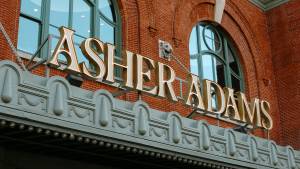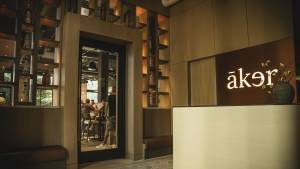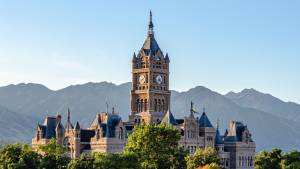Joshua Jones
SIGNS OF THE TIMES | On The Street
We’ve had a lot of visitors in town recently. The one consistent adage we keep hearing is, “I can’t believe what is happening downtown, I don’t even recognize it!”
And, we agree, if you're not downtown every day, the speed of new, bright, and shiny things is hard to keep track of. So, here are the signs of the times, literally the newest signs at bars, restaurants, retail stores, hotels, and even a nail salon that have (or will) open this Fall.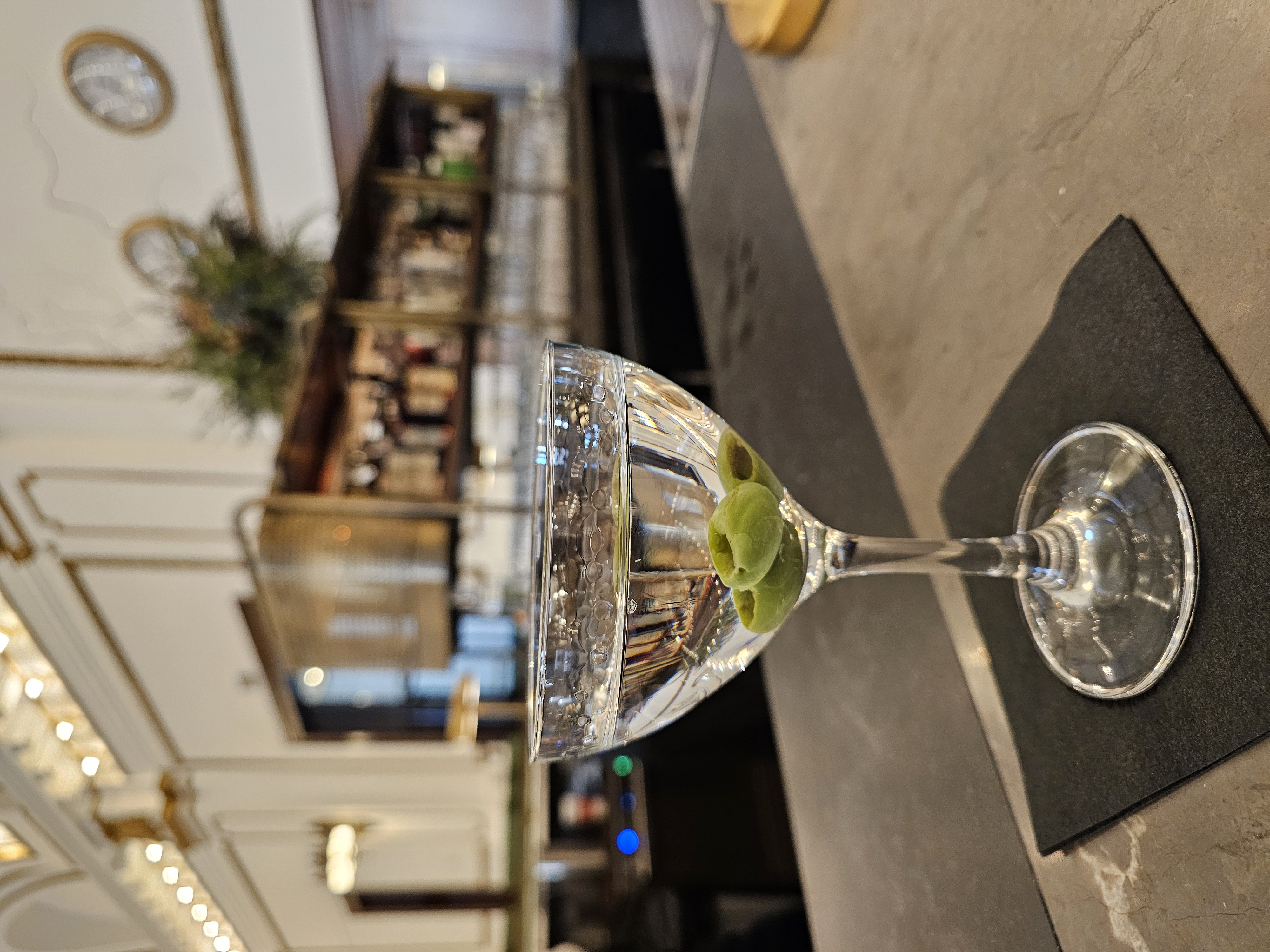
First up, Asher Adams is an extraordinary addition to Salt Lake and The Gateway. The Marriott Autograph Collection hotel is in the historic Union Pacific Depot with 225 moody and modern rooms and suites.
For locals, there are four food and beverage outlets. We’re positively giddy about the lobby bar where we wandered on Saturday and met bespoke service from Chad. The train station has been lovingly restored and both harkens to a golden era of train travel and also feels like a marvelous museum. Glowing stained glass and murals tell the story of Utah and can be studied for hours, especially while sipping Chad’s Old King Cole Cocktail with a plate of tuna crudo or crab toast. Rouser is the rousing American restaurant that feels casually elegant. Everything is cooked over charcoal, including one of the best octopus dishes we’ve had.
We’re sending our field reporter, Melissa Fields (get it?) on a mission to talk to the architects for a deeper report we’ll publish in the near future.
Montreal-based retailer, GARAGE has opened on the east block at City Creek Center, second floor. It is a casual clothing brand for young women with an eye for denim. Looking to be confidently ‘gram-worthy? Find your way to City Creek Center’s garage, two-hour free parking.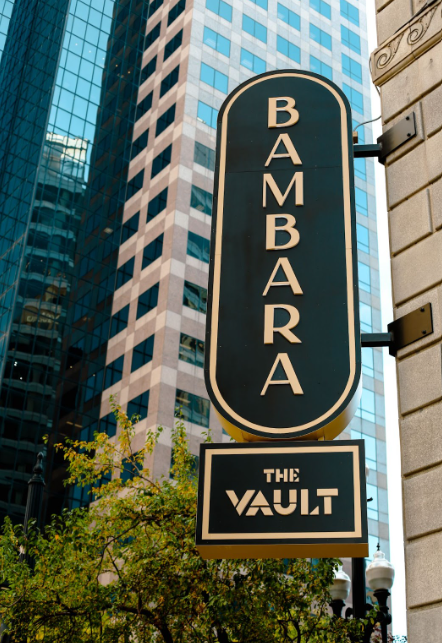
We saw Hotel Monaco’s handsome signage for Bambara going up a month ago and love the aesthetic. If you still haven’t checked out the newly renovated Vault, you’re missing out on a gorgeous, quiet lounge for dinner before a show at Capitol or Eccles.

Sugarhouse’s Heart’s Nail Spa will open a second location in the US Bank Building on 200 S. and Main. We’re not mani pedi people, but we’re open to new experiences. In fact, working across the street, we hope to be the first to try the Milky Honey Manicure once they open!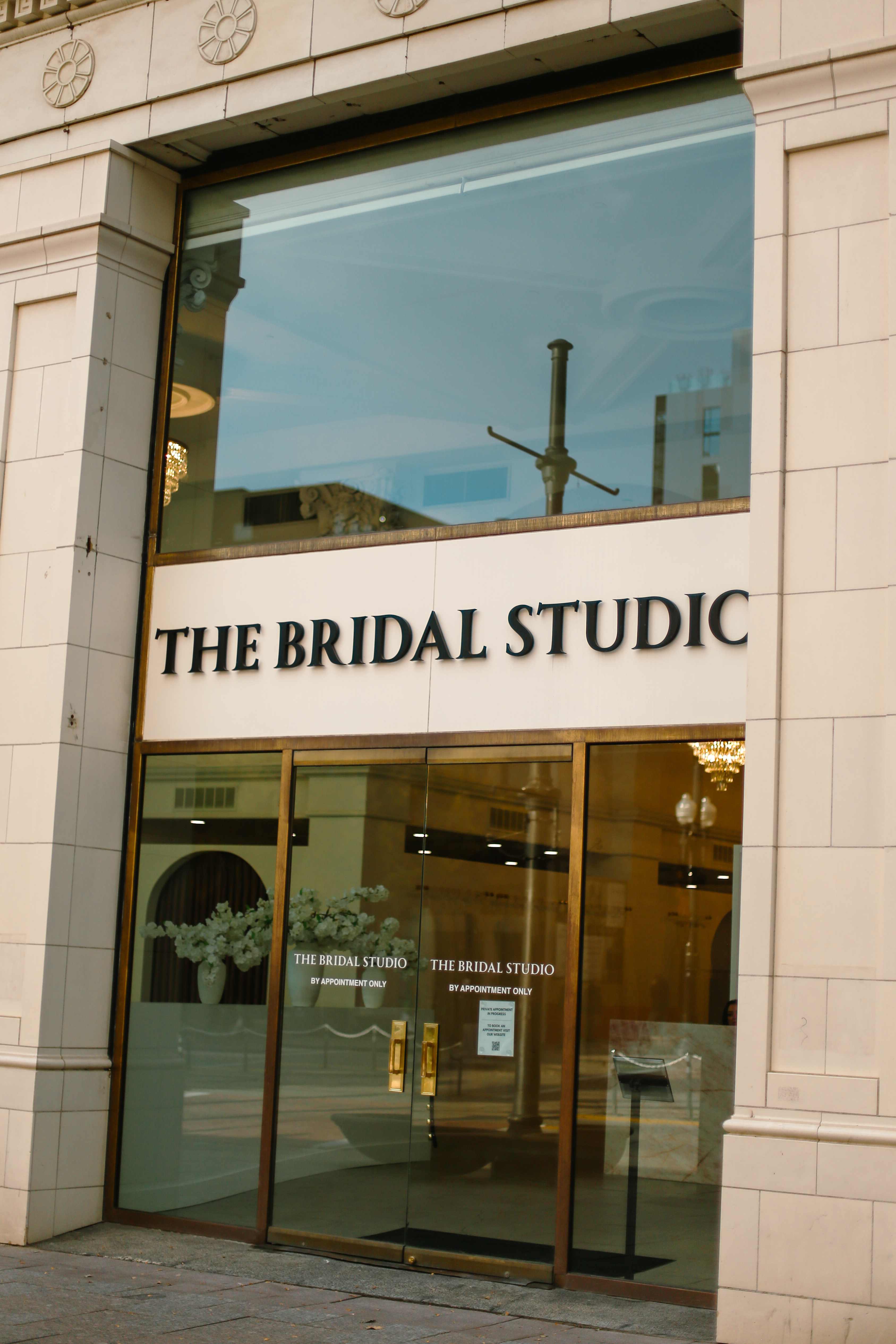
Bridget opened The Bridal Studio on Main Street wanting to create a luxurious experience for brides. We’re not sure you could ask for a more fanciful location in the regal Kearns Building to feel fabulous. Their curated collection offers bridal gowns from around the world you won’t find anywhere else in Utah. Make an appointment and they’ll have the bubbles on ice!
The new sign at Sayonara stands out like a Bengal tiger in the outback of Bhutan. At this vibrant and voluminous lounge on State and Broadway don’t miss the mellon ball cocktail with togarashi fries.

MORE RESTAURANTS, PLEASE!
Ok, Aker Restaurant and Lounge has a stand-out sign, but the modern coastal Mexican resort vibe, the gorgeous bar, and the beautiful, delicately-created sushi is drool-worthy. Come for all that and stay for the scene… everyone is ready for a night in SoHo or WeHo. (Don’t let that discourage you from enjoying it, we went in a hoodie and jeans.)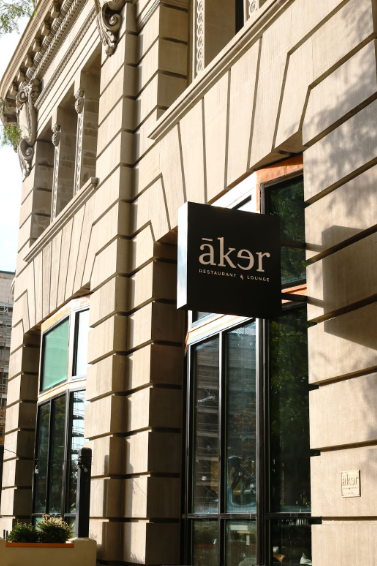
Italian Graffiti at The Gateway is now Lupessa. We can’t figure out what Lupessa means, but everyone can agree it is a better name than Italian Graffiti. We visited the location at opening, and it seems the new menu leans into a more authentic Italian experience. And, Alex Springer’s review in City Weekly makes us want to return soon!
PHOTOGRAPHY BY KELLI FRESHMAN
More Sushi! More Mexican! More Everything!
We were stunned when Ryan Lowder closed The Daily. It was a favorite coffee shop with a casual sophistication. The space inside the 222 tower is being fully redesigned for Hando Sake, a Japanese restaurant specializing in temaki sushi, or hand rolls. They are also promising a full bar and live music (rad)! We’re getting a September feeling on opening, based on a peek inside.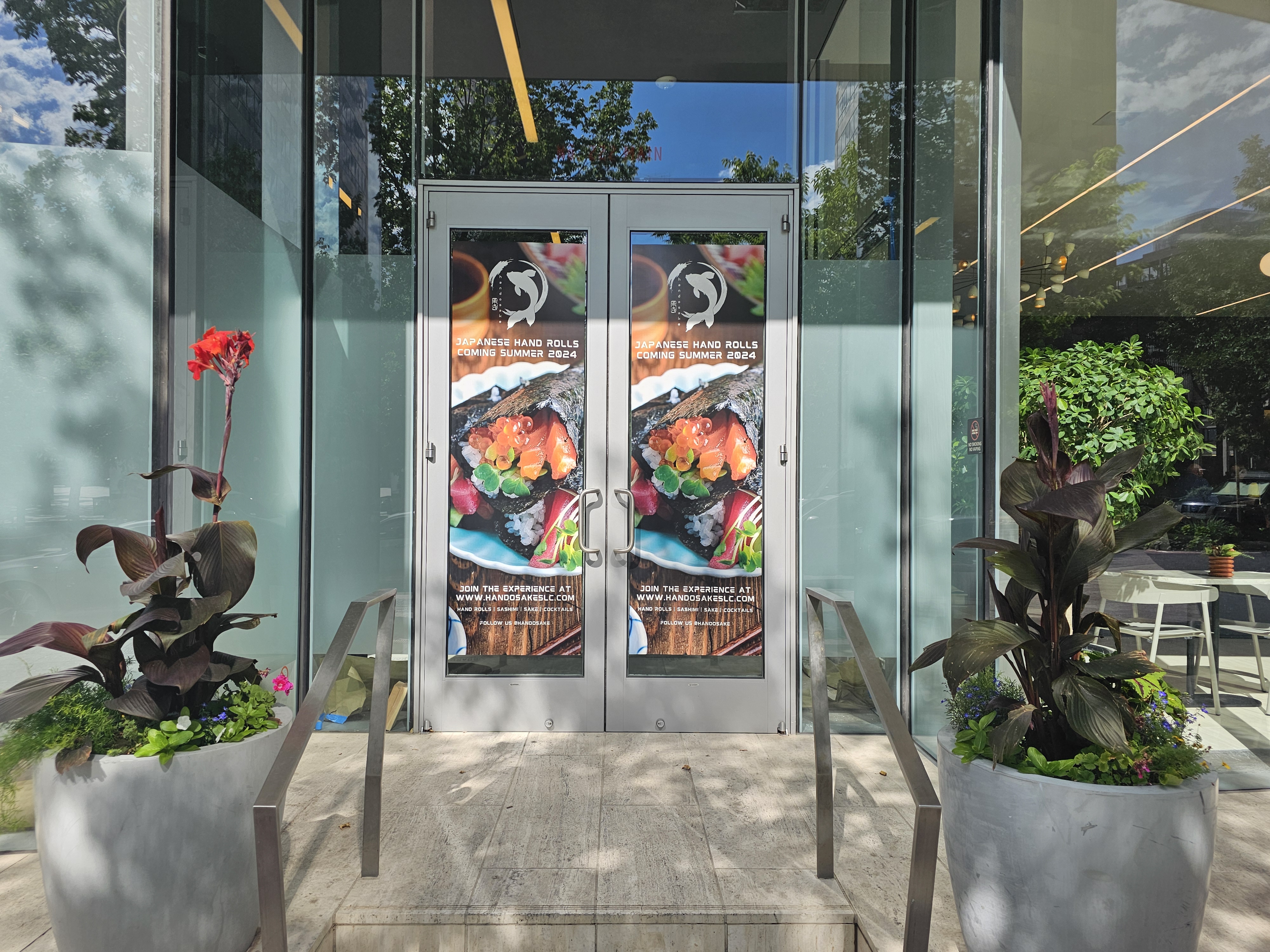
Speaking of high-end sushi, as first reported here, Aker Restaurant and Lounge has opened in the Boston Building (where Maxwell’s was once located). Imagine swimming in Bahia de Banderas, showering and entering one of the luxury restaurants in Punta Mita. Lush golden hues and light beats nestle you into a calm drift as you sip an exotic cocktail and dine on the freshest fish like maguro with blueberry habanero jam, or miso cod marinated for 24 hours in a three miso blend glazed with hajikami. That’s how it transported us, anyway. This restaurant is going to be the “it” spot. Be an influencer and check it out before all your friends tell you about it. 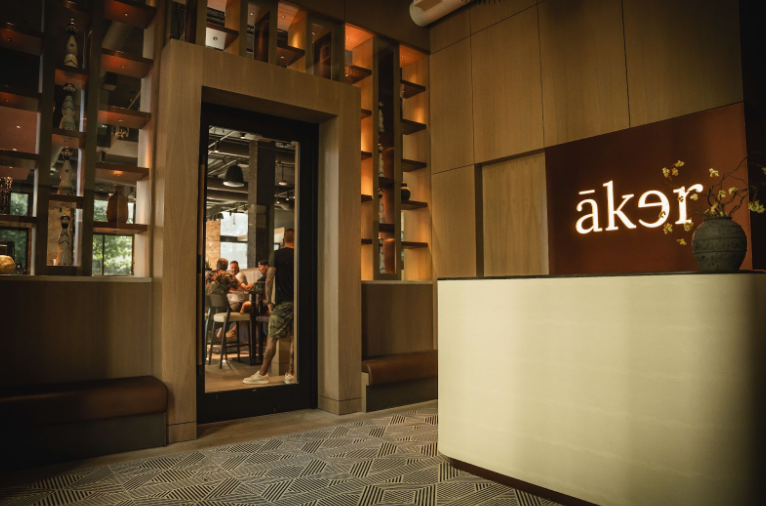
Fallan Keyser has closed Good Grammar and will fully convert it into a new concept. They should be open this week. We’re hearing the space will continue operating as a 21+ and be early morning to late night. Start with coffee in the morning, after work drinks and a late night vibe that will be a bit more muted than Good Gramar’s ruckus energy. Perhaps more like the aforementioned Daily’s vibes? The front door has a cryptic passage, “A small group of people with shared interests or tastes, especially one that is exclusive of other people.” Which, of course, is the definition for a clique or coterie… so that’s our bet for the name. 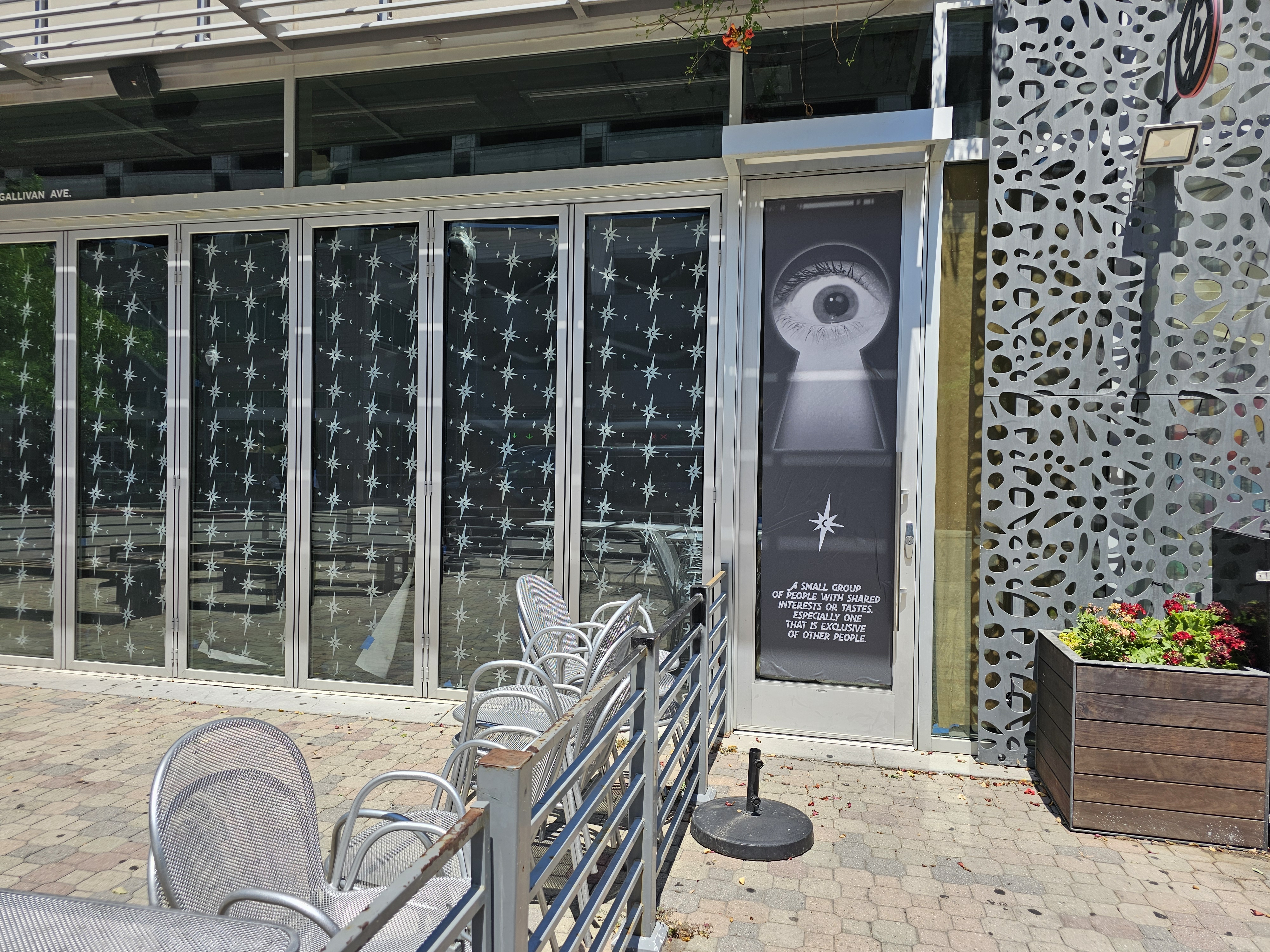
Yes, we used google to figure that out. What kind of genius idiot do you think we are?
Don’t overthink the name, people! Chinese Bistro has very quietly opened on Regent Street. There was nothing happening in the old FeastBox space for months, and then poof! It is super fast casual and our first taste of the popcorn chicken was very tasty with three dipping sauces.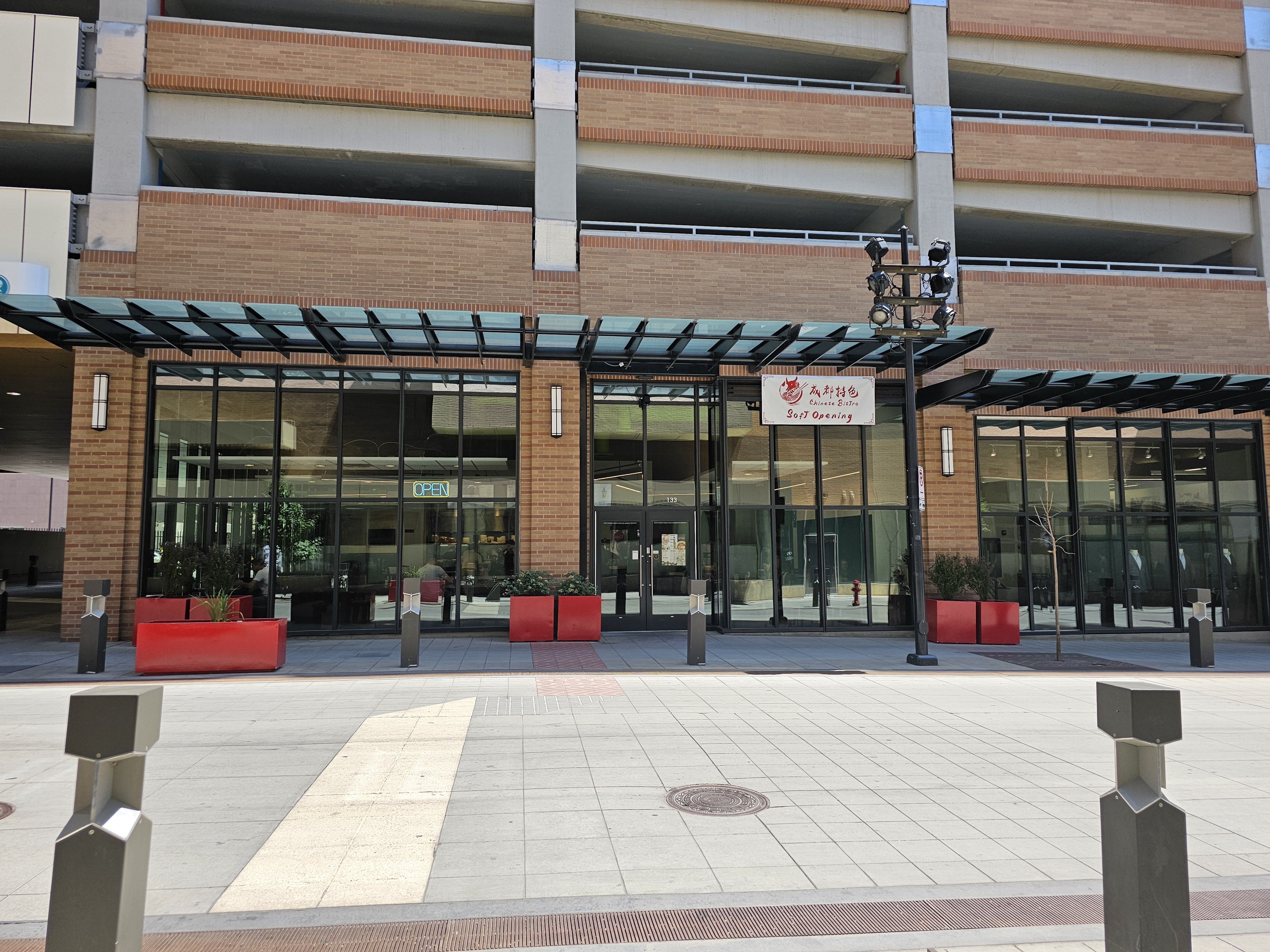
Vanessa Notini and Erick Pernia, owners of Arempa’s have stealthily opened Earth and Stones Cocktail Bar at 63 Exchange Place, once home to the venerable Heavy Metal Shop. Kolbie Peterson with The Salt Lake Tribune says to expect a Japanese aesthetic with a quieter atmosphere than the bars nearby.
So long Pollo Loco! The short-lived chicken shop in the US Bank Building changed hands and names overnight. Mr. Melling at Gastronomic first reported it is now Mi Buena Vida, a fast casual chain owned by Alan Galeano that we’re excited to try. The menu is a bit more diverse than Pollo Loco with ceviches and Mmm…moles. Right next door, Alan is opening his namesake, Galeano’s Restaurante Italiano. He owns some well-regarded restos in Park City, so big anticipation!
THREE NEW RESTAURANTS COMING TO BLOCK 47
If you thought there was a lot of progress recently in Downtown Salt Lake… get ready for a meteoric 2024.
Downtown’s population will double this year, with Astra, Revival, and Worthington ushering in hundreds of apartments. This will require more restaurants, social establishments, and expanded amenities like third spaces, parks, dog runs, and transit options.
The F+B scene is ready to explode with the impressive, celebrity-driven STK opening earlier this month in the West Quarter; and mind-boggling nightclubs coming to The Gateway: Electric Fish and Neptune’s Palace.
We’ve been plying our sources for information on the prolonged renovation of the magnificent Maxwell’s space in the Boston Building. You’ll remember that it is one of the most spacious rooms downtown with gorgeous views of Main Street and a dynamic patio setting. (Maxwell’s Tiny Pub relocated to 200 South and 357 West). We can finally reveal that HP Management will open its new brainchild, Aker Restaurant and Lounge late this spring. “A groundbreaking concept that seamlessly marries the culinary finesse of upscale cuisine with the dynamic allure of downtown’s nightlife.” Hmm, intriguing. Digging in further we found they’ll specialize in Japanese cuisine, specifically robatayaki (think small, slow-grilled skewers over charcoal). An upscale atmosphere will transform into an “alluring contemporary lounge” in the later evening. They seem to have the money to bring something special to market, so we’ll keep spying on the space!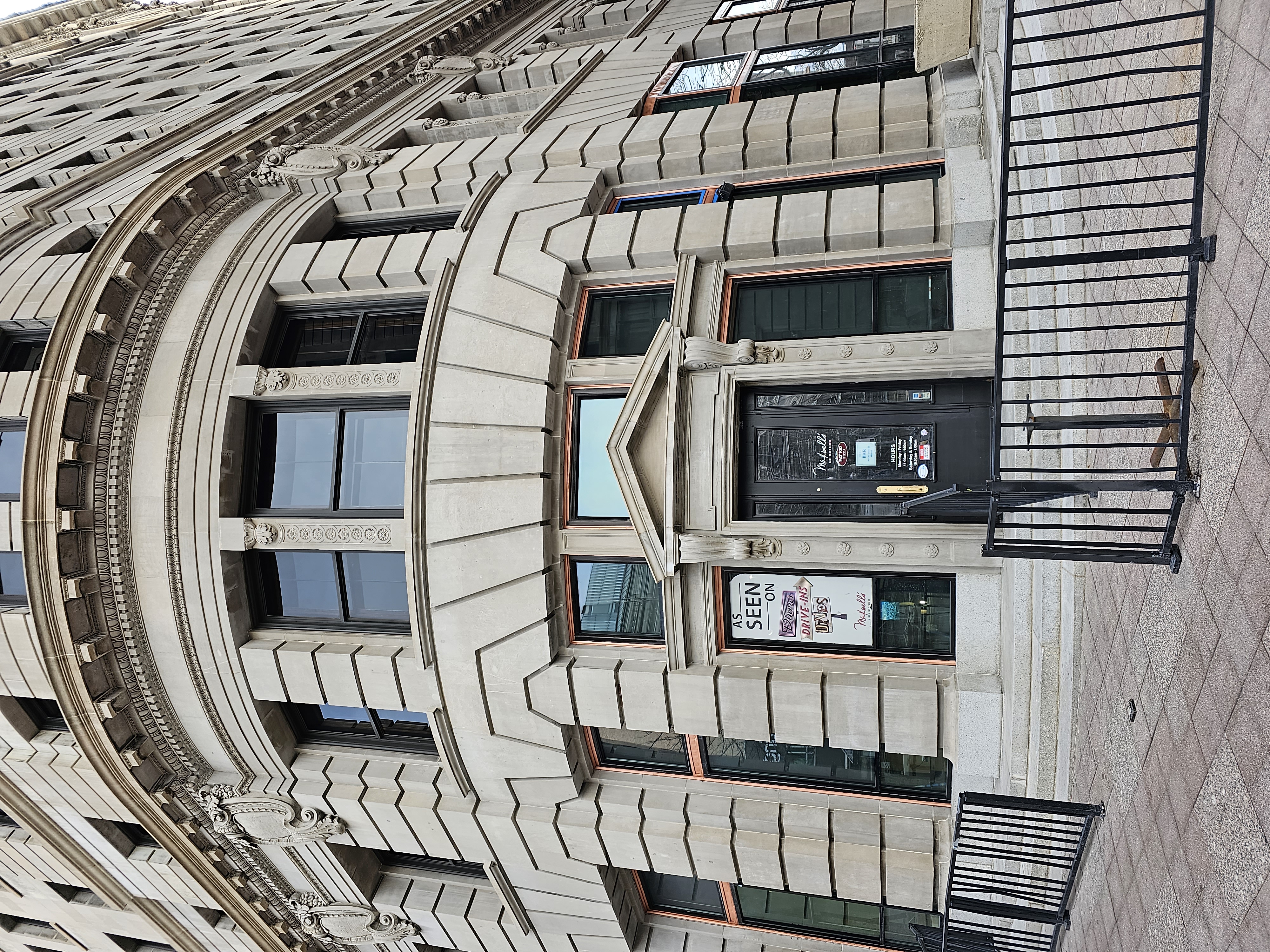
Next door, at the short-lived Pago on Main, a vinyl wrap is up for Felt Bar & Eatery. While taking spy photos, owners Rich Romney and Travis Herbert invited me in for a peekaboo. A gorgeous 30-seat bar wraps the interior in cool blue hues and modern chandeliers drip from the ceiling. The space is sophisticated, but deeply approachable, plus these two have the chops to raise the barre on service. Rich was with Takashi for 15 years and Travis has 18 years experience in fine dining. They hope to have their license in February.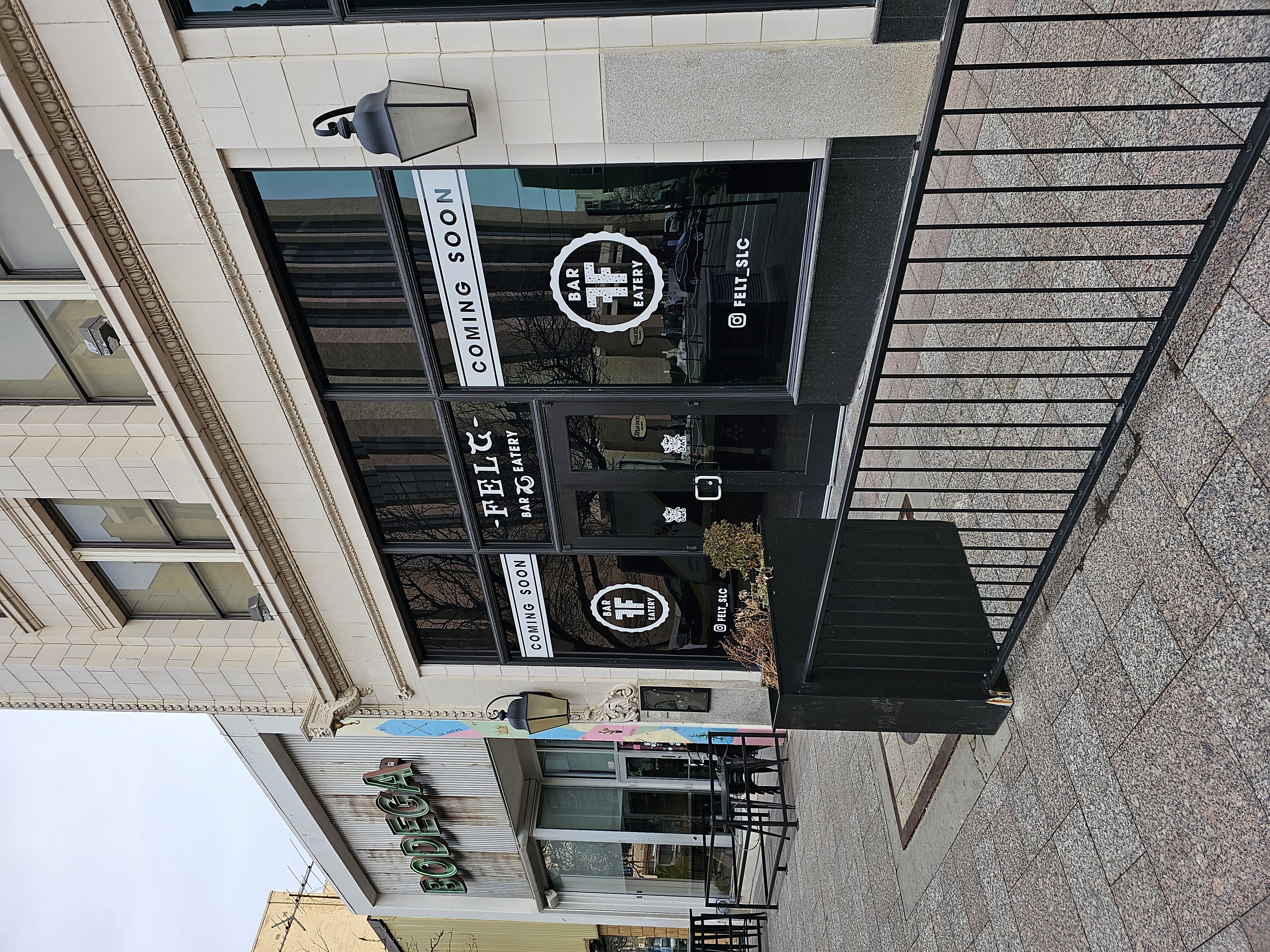
We’d be remiss not to mention that, after closing Pago, Scott Evans opened Finca Pintxos Bar on Regent Street and everyone 21+ should try the gin cocktails and Spanish tapas.
The reliable source that gave us the lowdown on Aker, also whispered an update on Repeal, coming to the Walker Center’s basement, (the old Bourbon House). They are taking their time to get the space perfect and expanding not only the footprint, but doubling the kitchen! Live music (especially jazz) will float through the space, which reminds us of D.B. Coopers. Anyone else remember?
On the same block, the old Circle Lounge (we’re really in the archives today) is going to get a second life as a supper club from a new-to-state operator. (FYI, for those who remember, the circle has already been removed). More info next month!
Finally, Lake Effect is now open everyday for lunch, starting at 11am! We can vouch for the chicken burrata sandwich. The drinks and luxurious atmosphere will have you wondering, “do I need to go back to work?” 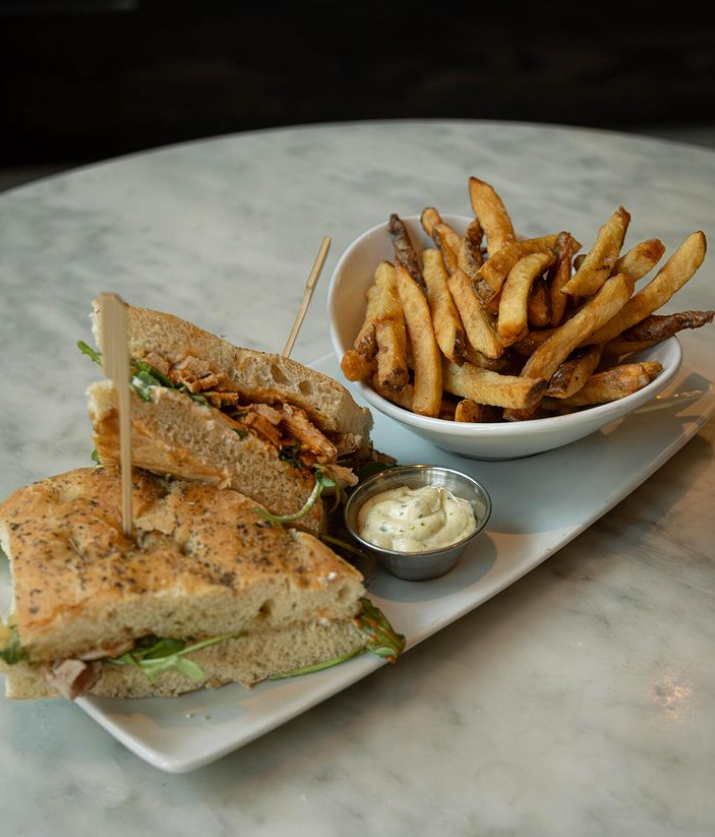
One postscript dear reader, if you ever wondered just how observant we are (nosy and nerdy) we were thrilled to notice Melting Pot’s new signage. 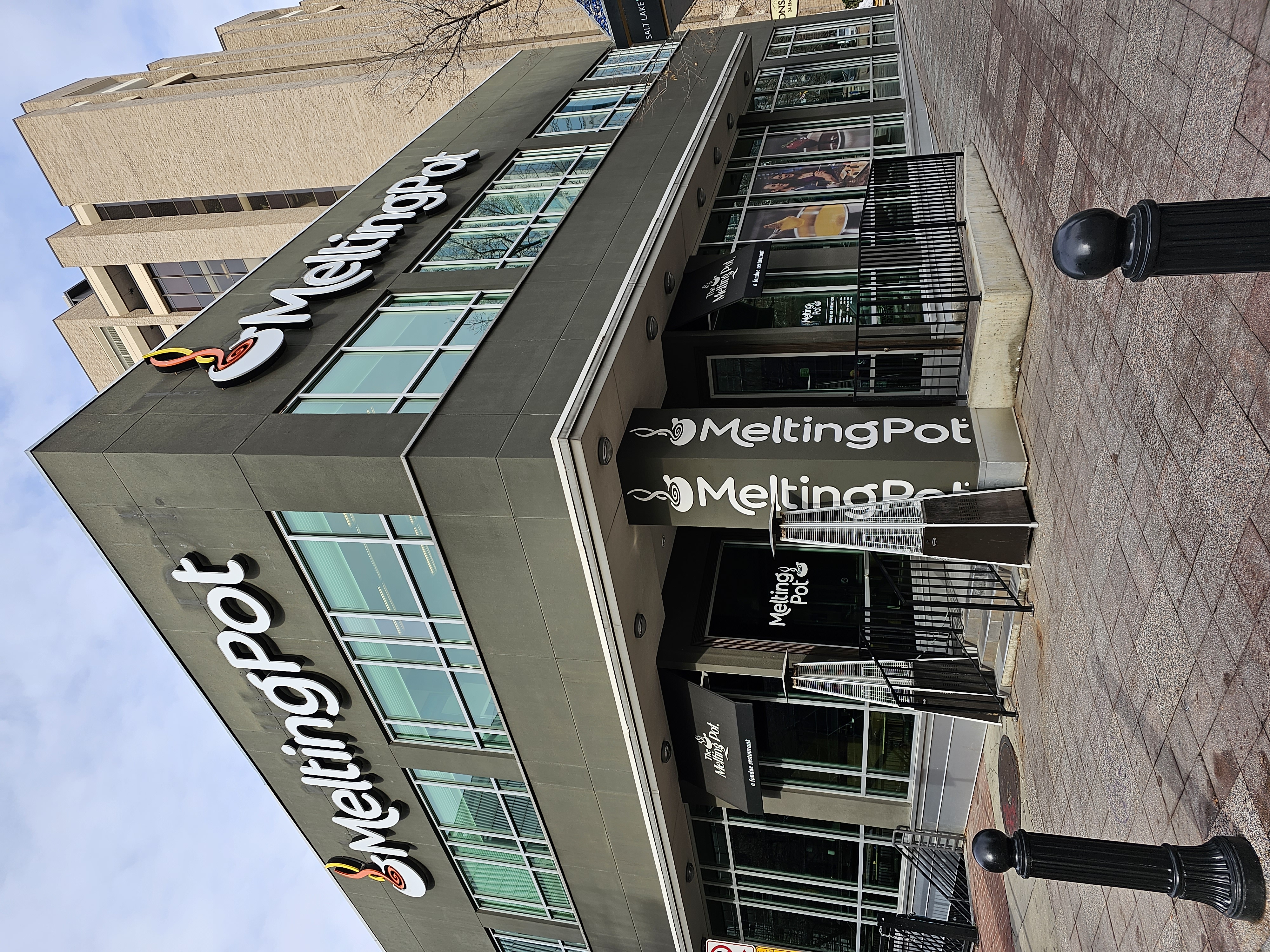
ANA VALDEMOROS
ANA VALDEMOROS
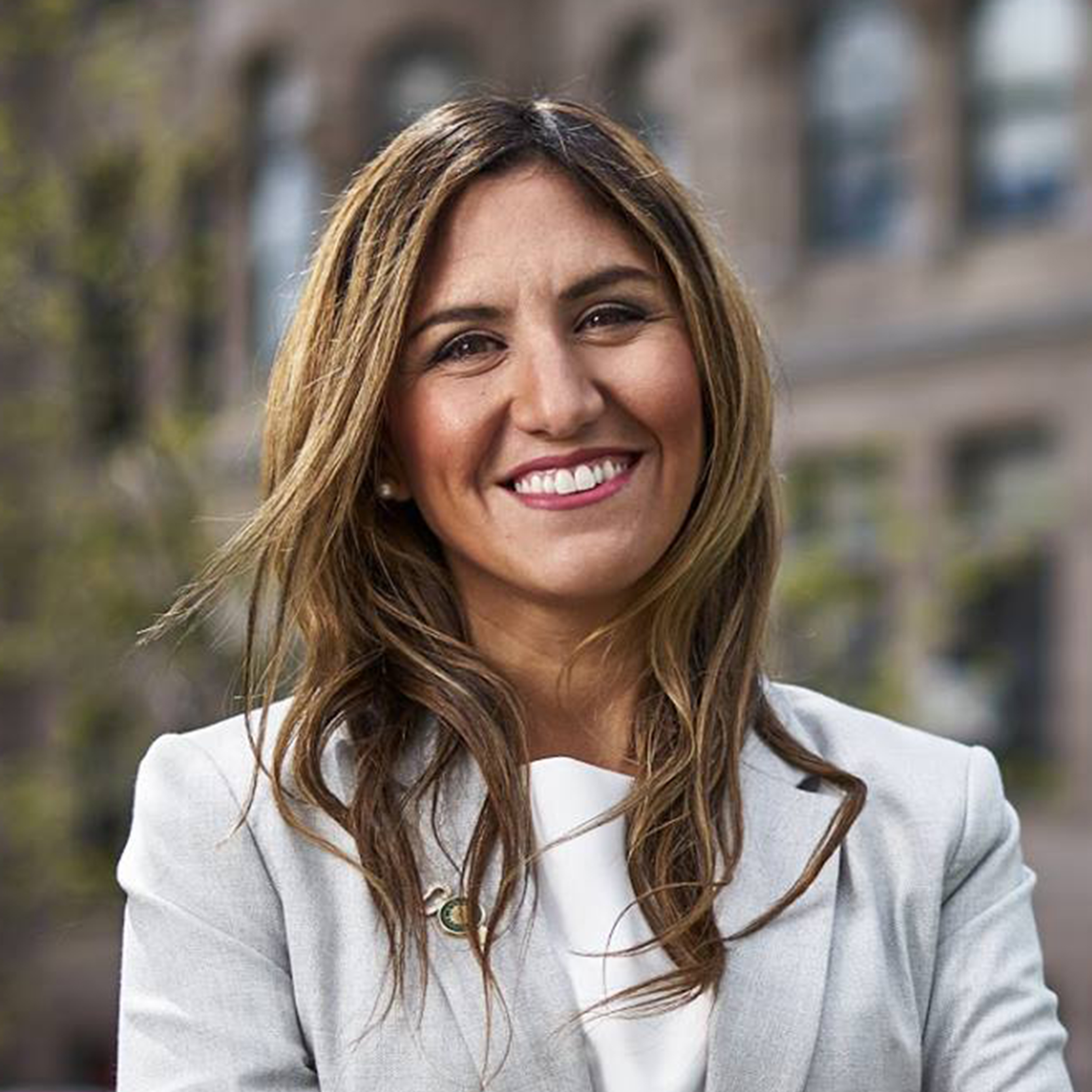
1. What is your vision for the Station Center neighborhood (200 South to 400 South; 450 West to 600 West)? What investments do you think the City should make in this area?
My vision for the Station Center neighborhood focuses is to transform it into a vibrant, family-friendly, and sustainable neighborhood, fostering economic growth and community engagement. To achieve this, I propose the following investments:
- Family-Oriented Amenities: We should introduce family-friendly amenities to attract and retain families in the area.
- Balanced Development: A mix of commercial and recreational spaces should complement existing attractions like Pioneer Park and the Farmers Market.
- Zoning Amendments: Amending downtown zoning districts to allow for increased building height can incentivize development.
- Mixed-Use Development: Emphasis on mixed-use development, improved public transportation, and pedestrian infrastructure.
- Green Spaces and Parks: Create green spaces and parks to enhance the quality of life and reduce car dependency.
- Affordable Housing: Implement policies and incentives to address affordable housing within Station Center.
- Sustainability: Incorporate energy-efficient buildings, waste reduction, and green infrastructure for a sustainable environment.
- Community Engagement: Actively involve residents and stakeholders in decision-making processes to align with community wishes and needs.
2. What are the most important initiatives and investments you will lead to create a safe and welcoming downtown for residents, workers, employers and visitors?
To create a safe and welcoming downtown, I am committed to leading the following key initiatives:
- Vibrant Communities:
- Park Revitalization: I secured $15 million in funding for Pioneer and other District 4 parks, transforming them into vibrant recreational spaces. Additional investments will revitalize parks and make them more accessible.
- Small Business Incubation: I supported small business incubation, particularly in the food industry, to promote economic vibrancy in our downtown area.
- Supporting Local Businesses:
- Financial Aid for Small Businesses: During the pandemic, I allocated $1 million to provide financial assistance to small businesses, later adding $2 million from federal sources. This aid helped businesses weather economic challenges
- Promoting Safe Gatherings: I facilitated safe gatherings by loosening regulations and waiving fees for outdoor dining. We temporarily closed Main Street to create a welcoming atmosphere, providing financial support for outdoor dining equipment.
- Ensuring Public Safety:
- Dedicated Business Liaison: I added a police officer as a business liaison in downtown Salt Lake City to strengthen the connection between law enforcement and the business community.
- City Departmental Audits: I reinstated yearly random City Departmental Audits to enhance transparency and accountability within city departments, ensuring efficiency and effectiveness.
- Public Safety Investment: I have secured record funding for the police and fire departments and promoted alternative response models, including ambassadors.
In summary, my track record as a City Council member demonstrates a commitment to creating a safe and welcoming downtown. I will continue to advocate for these initiatives, focusing on vibrant communities, supporting local businesses, and ensuring public safety to contribute to the well-being and prosperity of District 4 and the city as a whole. Our downtown is the economic engine of our city, deserving of strategic investment to generate the return we need.
3. Salt Lake City’s Central Business District population will double in the next two years. How can the City enhance and expand green space and public spaces to support a healthy and vibrant downtown neighborhood?
To support a healthy and vibrant downtown neighborhood, I propose the following key strategies:
- Green Loop Initiative: We recently piloted the Green Loop to assess the need for more green spaces in downtown. The positive results indicate the importance of this project. We will invest in the Green Loop as envisioned in the downtown plan to create a continuous network of parks and green spaces.
- Open Streets Program: Driven by the community's desire for pedestrian-friendly spaces, I have funded a study to understand the infrastructure changes and costs needed to permanently close streets to automobiles. This initiative is currently underway.
- Sustainability Focus: Salt Lake City is a leader in sustainable practices. We will continue to prioritize sustainability by enhancing building efficiency, reducing carbon emissions, and improving air quality. We will also work to ensure access to fresh and healthy food options in the downtown area and focus on conserving natural resources.
- Zero-Waste City: My commitment to making Salt Lake City a zero-waste city involves comprehensive waste reduction, recycling, and composting programs.
- Cultural Vibrancy: To maintain our district's status as a cultural hub, I will advocate for budget allocations to support the arts and seek partnerships with private donors and nonprofits.
- Sustainable Transportation: I will promote eco-friendly transportation options, such as walkable and bikeable roads and efficient travel choices, to reduce our carbon footprint.
4. What is your plan for responding to the crisis of people living without shelter on the streets of Salt Lake City? Will you enforce no-camping ordinances? Please include your strategies for funding the initiatives that you propose.
Addressing the housing crisis, homelessness, and mental health issues requires a comprehensive and compassionate approach. Here are the key initiatives and strategies I will lead:
Housing Initiatives:
- Safe Outdoor Spaces: I allocated $500,000 for safe outdoor spaces, offering dignified living conditions and enhanced security for unsheltered individuals.
- Affordable Housing Investments: I successfully advocated for over $20 million in affordable housing investments, promoting affordable rents and neighborhood preservation.
- Smart Zoning Changes: I championed zoning changes to allow for taller buildings in Downtown districts, promoting sustainable urban growth.
- Balanced Rezoning: I approved rezoning while protecting existing housing and preventing displacement of affordable units.
- Accessible Housing: I removed conditions for Accessory Dwelling Units (ADUs) and secured funding to promote affordability.
- Family-Sized Housing: I incentivized family-sized housing and affordable homeownership to accommodate diverse needs.
Mental Health and Addiction Support:
- Community Health Access Team (CHAT): I created CHAT to respond to service calls requiring specialized support, saving police calls and providing assistance to individuals in crisis.
- Receiving Center: I secured $3 million for a temporary receiving center, diverting individuals with mental illness from the criminal justice system to receive medical services.
- Community Policing: I funded police squads to support sheltered and unsheltered individuals.
- Downtown Enhancement: I funded yellow shirt ambassadors to maintain order and cleanliness in downtown areas.
- Advocacy for Mental Health Services: I've advocated with government agencies to prioritize mental health services.
- Community Park Reclamation: I led efforts to reclaim Taufer Park, making it a more inviting and secure space for the community.
Future Initiatives:
- Secure Outdoor Spaces: I plan to rally my colleagues for increased funding to establish a comprehensive, RV-inclusive second sanctioning camping ground, addressing the needs of our community to build off of the $500,000 I recently allocated for secure outdoor spaces, emphasizing dignity with amenities like bathrooms.
- CHAT Continuation: I aim to continue the momentum of the Community Health Access Team I established in my first term, which, in under a year, saved over 100 police calls by providing specialized, compassionate responses, thereby enhancing overall community well-being.
These actions and future initiatives demonstrate my commitment to addressing these challenges in a compassionate, inclusive, and responsive manner to ensure the well-being of all Salt Lake City residents.
5. Please share your strategies for attracting and retaining employers and skilled workers to Salt Lake City.
Attracting and retaining employers and skilled workers is crucial for Salt Lake City's growth. Here are my key strategies:
Infrastructure and Transportation:
- Invest in mass transit and bike/pedestrian infrastructure to reduce congestion, improve commutes, and enhance quality of life.
- Support Vision Zero to ensure safer streets and prioritize public transit.
- Continue funding for UTA bus lines and the student pass program to encourage public transportation use.
Education and Workforce:
- Partner with educational institutions to create a skilled workforce through training programs, internships, and apprenticeships.
- Ensure access to quality education from K-12 to higher education.
Business-Friendly Environment:
- Streamline permitting and licensing processes to reduce bureaucratic hurdles for new businesses.
- Offer incentives for job creation, including tax breaks and grants.
Innovation and Entrepreneurship:
- Promote business incubators and accelerators to support startups and innovation.
- Facilitate access to capital for local businesses and startups.
Quality of Life:
- Invest in cultural and recreational amenities to enhance the city's appeal.
- Address housing affordability to attract a diverse range of workers.
Sustainability Initiatives:
- Prioritize sustainability and environmental practices to attract environmentally conscious businesses and workers.
Collaboration and Networking:
- Encourage business participation in local associations and foster a collaborative ecosystem.
Diversity and Inclusivity:
- Embrace diversity as a strength, celebrate differences, and promote equal opportunities for all residents.
- Act as a unifying bridge that transcends backgrounds, fostering inclusivity and unity in the city.
In conclusion, Salt Lake City's attractiveness to employers and skilled workers is enhanced through a combination of infrastructure investment, education, business-friendly policies, innovation support, quality of life enhancements, sustainability, collaboration, and a strong commitment to diversity and inclusivity. These strategies will contribute to the city's continued growth and prosperity.
6. How can the City best support the Utah Jazz’s long term residency in Downtown Salt Lake City?
Ensuring the Utah Jazz's continued presence in Downtown Salt Lake City requires a multifaceted approach that strengthens our city's cultural and economic vibrancy:
- Lease Renewal: We've taken the crucial step of renewing the Utah Jazz's lease, providing stability and commitment for their long-term residency. This extended partnership fosters trust and encourages further investment.
- Development and Infrastructure: To bolster the Jazz's residency, I am actively supporting the development of the surrounding area. This includes both land use and financial incentives to attract businesses, residential projects, and entertainment options. This thriving ecosystem around the Jazz arena benefits the team and the community alike.
- Historic Japantown: I recognize the cultural significance of historic Japantown. I am dedicated to preserving and revitalizing this unique heritage, transforming it into a key attraction. Our plans involve restoration efforts and initiatives to celebrate and showcase the rich history of this area.
- Transportation Accessibility: To ensure fans can easily access games, we're investing in transportation infrastructure. This extends beyond airport connectivity and encompasses improved public transportation links to downtown. Convenient transportation options are vital for the Jazz's long-term success.
- Community Engagement: The Utah Jazz are more than just a basketball team; they're an integral part of our community. I am committed to fostering a strong connection between the team and local residents. Initiatives include partnerships with schools, charities, and community organizations, ensuring that the Jazz remain woven into the fabric of our city.
- Economic and Job Creation: The presence of the Jazz has a substantial economic impact. I’m focused on on maximizing these benefits, such as job creation and increased tourism, by supporting the team's long-term presence.
- Sustainability and Modernization: To keep the Jazz arena competitive and attractive to a diverse range of events, we're investing in sustainability measures and modernization. A modern, eco-friendly facility not only benefits the environment but also enhances its appeal to a wider range of audiences and events.
7. What is one of your favorite dishes from a restaurant in the Central Business District?
This is probably the toughest question I’ve been asked on the campaign trail since there are so many great dishes to pick from. However, one of my all-time favorite dishes from a restaurant in the Central Business District is the Steak Sandwich from Franklin Ave. Its succulent flavors and perfect balance of ingredients make it an absolute delight. Of course, the district offers an abundance of exceptional dining experiences, and my family and I are on a mission to explore them all. The Central Business District truly has something for everyone to savor.
8. What else would you like downtown property owners, merchants, employers and residents to know about your campaign?
Downtown Community,
I'm deeply committed to our city, and my record speaks to my dedication. With your support, I'll continue fostering fairness and balance, drawing on my expertise in city planning, small business, and my passion for sustainability. I'll be your voice, working to unite our diverse community.
I bring professional acumen and advocacy, which uniquely positions me to mediate among different groups, striving for unity and constructive collaboration. You can count on me to prioritize your concerns, making sure our downtown thrives.
I'll build on my past achievements and experiences, advocating for policies that improve life in District 4 and make our downtown more welcoming, safe, and prosperous for everyone. My vision includes inclusivity, sustainable growth, and a thriving business environment, ensuring our downtown remains a vibrant and diverse place.
I promise to continue to be accessible and accountable, valuing your input and actively seeking your perspectives. Let's shape the future of our downtown together. Join me in creating a place we're all proud to call home, work, and visit. Your support is invaluable, and I'm grateful for the opportunity to serve you.
Together, we'll make our downtown even better.
EVA LÒPEZ CHÁVEZ
EVA LÒPEZ CHÁVEZ

1. What is your vision for the Station Center neighborhood (200 South to 400 South; 450 West to 600 West)? What investments do you think the City should make in this area?
Access to opportunity is an important responsibility for District 4. With human-centered design, affordable housing nearby, access to the Rio Grande neighborhood, this community has amenities, greenspace, and housing ready for new residents. The Redevelopment Agency should take the opportunity of having city-owned property in this area to partner with the University of Utah and amplify the neighborhood for students and families. The proximity that this community has to the Fulsom Trail makes it an important pedestrian byway. It is exciting to imagine a district that uniquely integrates industry and connects into our West Side and East Side communities.
2. What are the most important initiatives and investments you will lead to create a safe and welcoming downtown for residents, workers, employers and visitors?
There are a plethora of opportunities to work together to help Downtown stay safe, welcoming, and vibrant to residents and visitors alike. Below are important initiatives that I will champion:
- Designing with, and providing direction to, SLCPD on a centralized security plan that incorporates non-police security teams and social services specifically in the Central Business District.
- Closing Main Street permanently to cars to become a pedestrian mall, like in international destinations.
- Expanding the network of pedestrian-friendly streets and adding more human-centered design.
- Outdoor seating has been a smashing success. It’s time to look at waiving (or at least reducing the barrier to) encroachment permits and lowering the entry for small businesses to encroach.
- Enforcing on the practice of land-banking – putting to beneficial use the empty retail space or lots that have not been a net-positive to neighbors, businesses, or our Main Street.
- Free UTA passes for service workers coming into Downtown.
These concepts have emerged from conversations with residents, businesspeople, and workers in Downtown. Anything I propose here (or ever) would be fleshed out with the input of local stakeholders.
3. Salt Lake City’s Central Business District population will double in the next two years. How can the City enhance and expand green space and public spaces to support a healthy and vibrant downtown neighborhood?
We are Salt Lake City! Beautiful mountains and wildlands are all around. People pick our city as their permanent home because we are not a concrete jungle. Our Downtown should leverage private-public partnerships (Bryant Park is an excellent model) to build a city that echoes the landscape of its natural environment.
- I’m interested in pushing design elements that incentivize more green-roofs to help cool our urban center but also invite the public to see our city from a different perspective.
- We need to wield public art as a tool to reverse the trend in blighted spaces and invite more community.
- I love the mid-blocks that have been intentionally designed such as Regent Street. This is another important design that needs to be continued as we build densely in Downtown.
- We need more wayfinding to help people explore these gems such as Pioneer Park, Dinwoody Park, City Creek, and Gallivan.
4. What is your plan for responding to the crisis of people living without shelter on the streets of Salt Lake City? Will you enforce no-camping ordinances? Please include your strategies for funding the initiatives that you propose.
Let me be clear: housing is a human right and should be the long-term solution to our crisis. That means we need to be aggressive in ensuring an adequate supply of supportive and entry-level housing options for people who need to transition back into stable situations.
That said, I’ve also worked on the issue from an enforcement perspective for a long time, in Downtown especially. It is my hope to fund and expand a Central Precinct Station that would redeploy community-engaged officers throughout the center of our City and Downtown. Studies show that to change the elements of crime that persist through urban areas like our Downtown, we need to activate the area through community events and retail activity, but most importantly, through visible human policing. An example of this is 300 S, when officers and I worked together to move our police cars and police officers to work in the visible line of sight to unsheltered residents that congregate daily, completely deterring criminal activity. I am interested in expanding a sanctioned camp to help the enforcement of the no-camping ban by giving an actual safe place for people who are chronically homeless. It is unacceptable that our beautiful Main Street has been allowed to remain blighted at the same time as growth is bringing so much potential to our city. I am also intrigued by the potential to look at transient room tax to capture a sliver of our tourism economy for reinvestment.
5. Please share your strategies for attracting and retaining employers and skilled workers to Salt Lake City.
People looking at resettling in Salt Lake City, no matter where they are coming from, will want access to schools, affordable workforce housing, safety, and beautiful pedestrian streets. I’m honored that Salt Lake City employees and local unions have put their trust in me this election as their endorsed candidate to advocate for their needs beyond a livable wage to invite them back into our city.
- Now, more than ever, our city needs to look beyond affordable housing and look at policies that help sustain people such as mixed-family housing allowing more than 3 unrelated people per household.
- Free TRAX usage for service workers accessing Downtown.
- Help folks access permanent housing through homeownership programs.
- Centralize a security program Downtown to help keep crime away from our store-fronts and business. Workers deserve to feel safe first and foremost, without harassment.
6. How can the City best support the Utah Jazz’s long term residency in Downtown Salt Lake City?
The needs of the Utah Jazz are critical to sustaining a long-term sports culture and community in our city.
The Delta Center itself serves many purposes: entertainment, sports facility, community building and more. It has diversified and broadened its reach and is helping shape our burgeoning city. SLC and the Council need to oversee a safe, exciting experience taking our TRAX into Downtown. Lengthening service times during Delta Center events and Utah Jazz game nights is the collaborative effort I will lead to get ticket holders into downtown and onto Main Street instead of heading straight back home.
7. What is one of your favorite dishes from a restaurant in the Central Business District?
It’s so hard to pick! I’m a big fan of the Gobbler, a delectable turkey, cranberry, avocado sandwich from the Robin’s Nest. I adore Caputo’s roasted red sandwich. For dinner, nothing makes me happier than eating at Takashi or Eva’s (no relation!).
8. What else would you like downtown property owners, merchants, employers and residents to know about your campaign for councilperson?
Downtown is growing, and the growth we experience is a tool we need to wield. This may sound corny but I really mean it, growth is a beacon for all and is quite literally expanding our horizon. Downtown is home to our hopes and dreams in a bustling city that also makes space for us to enjoy the surrounding cascading mountains, snow, and streams.
It has been my primary responsibility to care for our Downtown and advocate for it. It was my job to communicate with our stakeholders and connect them with tools such as grant funding and security to help them get through trying times. I’m eager to continue showing up; to work in the trenches with you and to build our vision of a world class city, together.
CLAYTON SCRIVNER
CLAYTON SCRIVNER
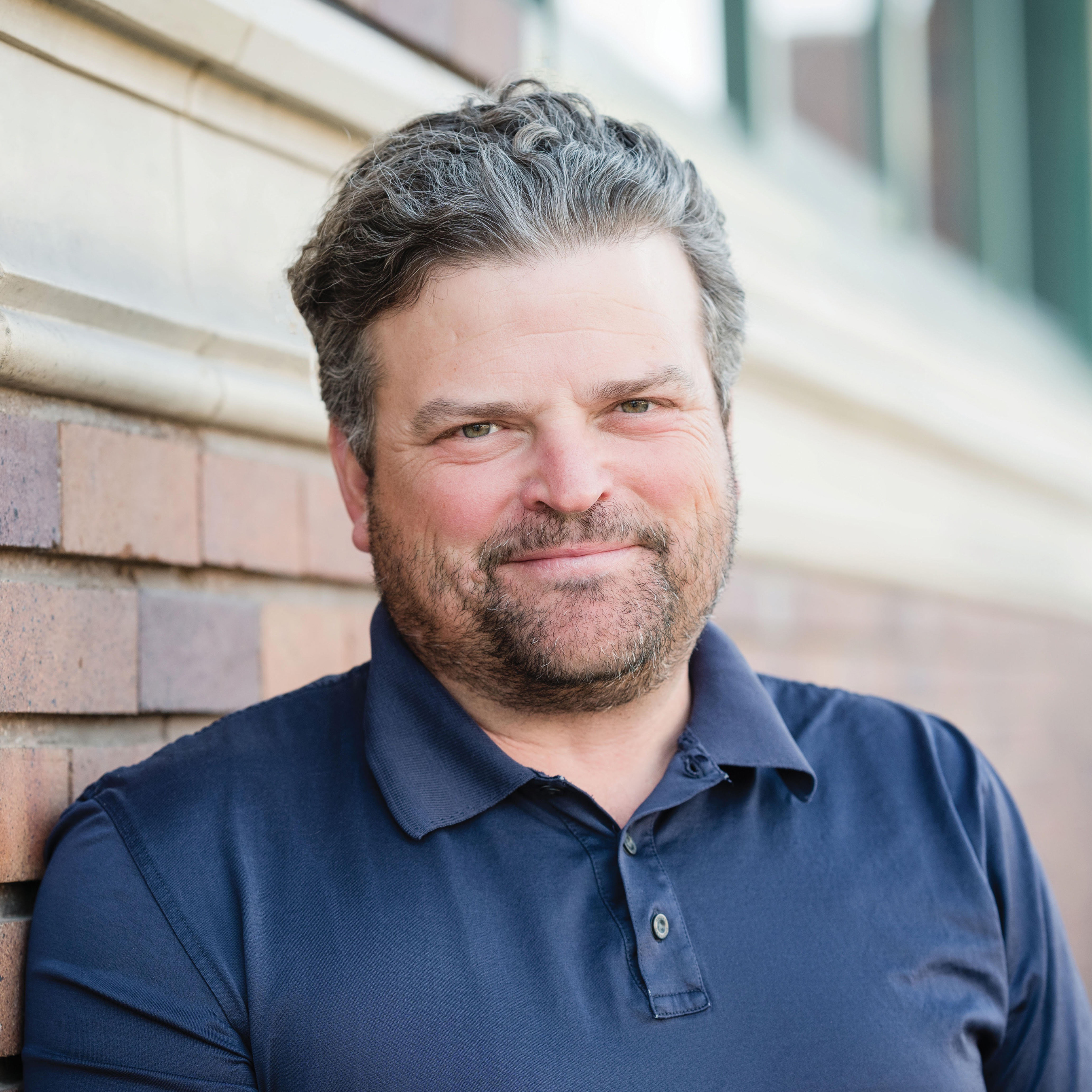
1. What is your vision for the Station Center neighborhood (200 South to 400 South; 450 West to 600 West? What investments do you think the City should make in this area?
This is a wild one to kick off with for me as I am intimately familiar with the Station Center area and the surrounding Depot District from my work at the Redevelopment Agency of Salt Lake City over a decade ago. In fact, if you don’t like the name Station Center, well I suppose I owe you an apology.
Station Center is full of nothing but potential and I would like to see that realized. Let’s go bold. I want a transformative effort on par with Denver’s Union Station project.
Much of this is articulated in the stakeholder-led Rio Grande Plan from just a couple years ago. It would take a lot of teamwork, but could you imagine a re-activated Rio Grande Building acting as a hub for regional and local transit? This effort, like in Denver, could be a catalyst to finally build Salt Lake’s most transit-connected neighborhood, hopefully still called Station Center, full of a healthy housing mix, local businesses, with amazing access to downtown.
2. What are the most important initiatives and investments you will lead to create a safe and welcoming downtown for residents, workers, employers and visitors?
First off, as someone who has spent three decades living, working, and playing in the Downtown Salt Lake City area, let me say it - Downtown is vibrant, fun, and in many ways better than ever.
That is not a statement made in denial of our challenges, we have them, and my approach would be threefold to address them:
- Listen to our Downtown stakeholders of all kinds and match their needs with City tools and lead our Council in being supportive of those needs.
- Prioritize maintenance of a clean and inviting environment and efficiently responding to reports of dangerous waste - tracking our response time and being transparent about efficiencies and deficiencies.
- Being tireless champion for increased access to mental health services, affordable housing, improved public transportation – and all other systemic barriers to creating an even more inviting downtown.
3. Salt Lake City’s Central Business District population will double in the next two years. How can the City enhance and expand green space and public spaces to support a healthy and vibrant downtown neighborhood?
Livability doesn’t happen without green spaces and vibrant open spaces in our urban core.
I am a staunch supporter of making Main Street an open street. This concept has been proven repeatedly in other cities where open streets enhance the health and vibrancy of downtowns and commercial nodes – and it is time we made our Main Street an Open Street. Permanently, not pop-up.
I also support the Green Loop. We must activate our wide streets and make them green.
As Vice- Chair of the Parks Natural Lands and Urban Trails Advisory Board (shout out to PNUT) I am supporting the first block of this project via our Capital Improvement Projects fund to start on the block of 200 E. between the library and City Hall. The first building block of what will be an amazing urban park network.
4. What is your plan for responding to the crisis of people living without shelter on the streets of Salt Lake City? Will you enforce no-camping ordinances? Please include your strategies for funding the initiatives that you propose.
Addressing the crisis of people living without shelter on the streets of Salt Lake City is a top priority for me. It's essential to approach this issue with compassion and with a comprehensive plan that combines immediate support for those in need with long-term solutions that address root causes.
To fund these initiatives, I'll explore public-private partnerships, grant opportunities, dedicated city budget allocation, creation of more deeply affordable housing, and tax incentives to ensure a comprehensive, compassionate, and sustainable approach to addressing homelessness in our city.
5. Please share your strategies for attracting and retaining employers and skilled workers to Salt Lake City.
I believe by investing in livability infrastructure, the arts, supporting local businesses, fostering diversity, inclusion, building community connections, and embracing sustainable practices we ensure the vibrancy and coolness of Salt Lake City. And when you up all of these factors - you are inherently attractive to businesses that want to be a part of something special.
6. How can the City best support the Utah Jazz’s long term residency in Downtown Salt Lake City?
The Utah Jazz can not, and will not, leave downtown Salt Lake City - not on my watch!
It’s hard to fathom that after a recent $125 million dollar remodel of the Delta Center (welcome back, Delta!) that this would be a thing, but I understand that the trend in professional sports management is to have entertainment districts surrounding new stadiums.
With a little imagination, and willing partners, that could happen right where we are now. Salt Lake City should and will be an active partner in assuring the Jazz stay exactly where they should be.
7. What is one of your favorite dishes from a restaurant in the Central Business District?
I’d have to say a Zesty Feta Doner from Spitz. If you haven’t tried it I’d highly recommend it!
8. What else would you like downtown property owners, merchants, employers and residents to know about your campaign?
My campaign theme is People First because I believe that when you prioritize people in every decision we make as a City, there is nothing we can’t accomplish. Downtown residents, property owners, merchants, and employers are an integral part of my People First equation. I am looking forward to listening and collaborating with these indispensable community leaders as we move forward with our shared goal of building a better Salt Lake City for future generations.
DISTRICT 4 CITY COUNCIL CANDIDATES DISCUSS DOWNTOWN
The Downtown Alliance asked candidates for the City Council District 4 to share their views on key issues that affect Downtown residents, workers, property owners, and visitors. The Alliance presents candidates' answers below to help voters make an informed choice in this important election. Click on the candidate photos below to see their unedited responses. The Downtown Alliance does not endorse any candidates for public office.
QUESTIONS ASKED:
1. What is your vision for the Station Center neighborhood (200 South to 400 South; 450 West to 600 West)? What investments do you think the City should make in this area?
2. What are the most important initiatives and investments you will lead to create a safe and welcoming downtown for residents, workers, employers and visitors?
3. Salt Lake City’s Central Business District population will double in the next two years. How can the City enhance and expand green space and public spaces to support a healthy and vibrant downtown neighborhood?
4. What is your plan for responding to the crisis of people living without shelter on the streets of Salt Lake City? Will you enforce no-camping ordinances? Please include your strategies for funding the initiatives that you propose.
5. Please share your strategies for attracting and retaining employers and skilled workers to Salt Lake City.
6. How can the City best support the Utah Jazz’s long-term residency in Downtown Salt Lake City?
7. What is one of your favorite dishes from a restaurant in the Central Business District?
8. What else would you like downtown property owners, merchants, employers and residents to know about your campaign for City Council?
ERIN MENDENHALL (Incumbent)
ERIN MENDENHALL
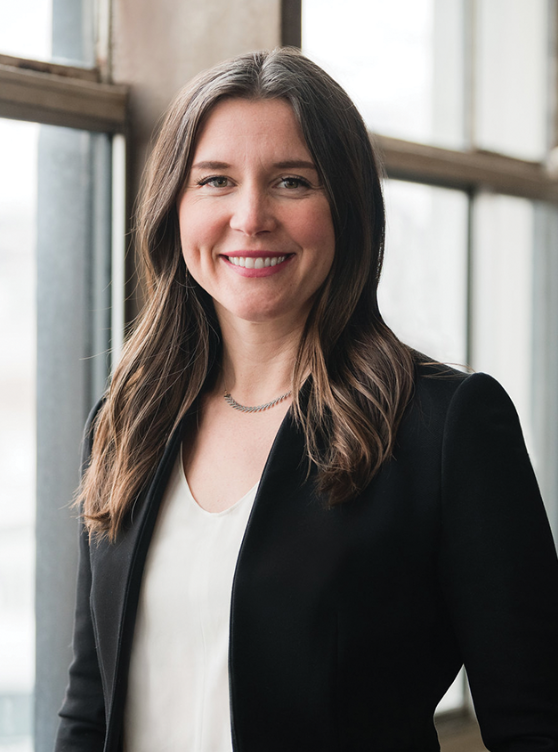
1. What is your vision for the Station Center neighborhood (200 South to 400 South; 450 West to 600 West)? What investments do you think the City should make in this area?
Station Center should be alive and thriving. My vision places significant emphasis on connecting to our city’s growing transit network, as well as improved walkability and friendliness to bicyclists by connecting the Green Loop through Station Center. We’re going to harness the creation of housing and the expansion of businesses to make the neighborhood an active center for life in the city, complete with local businesses and restaurants that make it a true destination. We want to incorporate the creation of community spaces – think pop-up event spaces, museums, maker spaces, etc. I want affordability AND an array of housing and tenant types in the neighborhood. And I envision Station Center as the home of our life sciences industry anchors within my Tech Lake City initiative.
2. What are the most important initiatives and investments you will lead to create a safe and welcoming downtown for residents, workers, employers and visitors?
Keeping people safe is the most important responsibility for any city and public safety isn’t something you achieve – it’s something you constantly work for and it’s an essential part of our quality of life. Total crime is near a 10-year low citywide, but there are still neighborhoods that are struggling and data doesn’t matter if you don’t feel safe. In my vision of the future, we will have a fully staffed police department – while other capital cities have struggled to stabilize their staffing since 2020, Salt Lake City is well on its way to achieving this goal. We will continue to hire trained civilians and social workers to handle non-emergency calls, freeing up sworn officers to focus on criminal matters; and we will have more community-based policing strategies and better trust between residents and officers. We’re also moving forward with our police substation on Main Street, which will be an anchor for our officers in Downtown to reduce response times and establish an ever-presence of public safety in our downtown core.
3. Salt Lake City’s Central Business District population will double in the next two years. How can the City enhance and expand green space and public spaces to support a healthy and vibrant downtown neighborhood?
The Downtown Green Loop has been discussed for years and after the great success of our demo project, I’m more determined than ever to make it happen — a linear park that would surround our downtown core and add as much as 60 acres of park space to Downtown, tapping our 132-foot wide streets and adding new including walking and bicycling trails. We want people to live, work and play downtown and adding this type of park space to our city would be transformative.
Open Streets started as a pandemic experiment designed to give people extra space and support our Main Street bars and restaurants is now closer than ever to being a permanent part of our city’s future. I want Main Street to become a pedestrian promenade to provide a consistent draw for visitors to our cultural core. Our shared vision for Main Street has always been to create a destination that enhances connectivity in our city, and closing Main Street to cars will be a contributor to the long-term livability and economic health of Downtown Salt Lake City.
4. What is your plan for responding to the crisis of people living without shelter on the streets of Salt Lake City? Will you enforce no-camping ordinances? Please include your strategies for funding the initiatives that you propose.
Everyone deserves a safe place to sleep at night. Just like every other state, Utah has experienced an increase in homelessness over the last few years, and it manifests mostly here in Salt Lake City. My homelessness strategy operates on six tracks: building a lot more housing of all types; bringing support services to the unsheltered; persuading the state and other cities to do their fair share; supporting the housed residents and businesses affected by homelessness; protecting tenants and helping more people stay in their homes; and reforming how we deal with criminal activities of the unsheltered. We’ve opened 434 units of supportive housing already — with more in the pipeline. Plus the tiny-home community, which could reach 400 units if fully built. The Temporary Shelter Community this winter will add climate-controlled pods for 50 more this winter. And I am proud to say that for the first time in decades the city, state and county are working together and making more housing and shelter beds than ever before.
The city has had an ordinance on the books banning camping in public spaces for decades but in 2018 a federal judge ruled that, essentially, the ordinance can’t be implemented if people don’t have an alternative place to go. Over the last 90 days, the average utilization rate of our homeless resource centers has been 99 percent, and the Utah Homelessness Council will tell you the system has been operationally at capacity since May. As housing units become available this winter and beyond, enforcement of that ordinance will adapt accordingly.
5. Please share your strategies for attracting and retaining employers and skilled workers to Salt Lake City.
Salt Lake City has one of the most educated and talented workforces in the West, if not the country, and we are so fortunate to have incredible academic institutions and some of the most innovative companies in the world right here. If we keep doing a better job of supporting our supporting graduates and entrepreneurs, and making it easier for them to build their businesses right here, we will be rewarded with a steady stream of economic opportunity. When I first ran for mayor, I identified six areas that were limiting Salt Lake City’s attractiveness to innovative businesses: the city’s reputation for being hostile to businesses; our poor air quality; the state’s reputation for poor treatment of women; insufficient housing supply; the region’s limited transit system; and a general lack of understanding of the city’s academic credentials. I could spend pages on each of these areas, but I’ll quickly note that my Tech Lake City initiative is designed specifically to address several of those areas (in addition to historic steps to improve our air quality and a 413 percent increase in the number of affordable housing units backed by the city each year). We are working closer than ever to support new high-tech businesses and attract others, including the development of an innovation district near downtown with a strong connection to the U. I’m excited by the growth we’re seeing in fintech, as well.
6. How can the City best support the Utah Jazz’s long term residency in Downtown Salt Lake City?
In addition to regular communication and partnership with the leadership of the Jazz, I am committed to building a true sports and entertainment district that ensures our Downtown remains the place fans want to go to watch a Jazz game. We’re already working with Downtown stakeholders to conduct a market analysis and ensure a strong public benefit and public participation in the creation of a district downtown anchored by the Jazz and additional pro sports. The nature of the Downtown landscape means that we must work with other property owners and other levels of government, which is bringing useful and constructive perspectives to the conversation. We also need to acknowledge that the future of professional sports is about the experience before and after games and the experience of transportation to and from the games. Salt Lake City is absolutely the best place in Utah for the future of professional sports. We are already growing in the way that best suits the future of professional sports, with our growing Downtown population, our awesome bars and restaurants, and our expanding transit options. The Green Loop will add even more culture to Downtown’s vibe.
7. What is one of your favorite dishes from a restaurant in the Central Business District?
The setas at Finca are just incredible.
8. What else would you like downtown property owners, merchants, employers and residents to know about your campaign for mayor?
When the COVID-19 pandemic hit, I stepped up with the nation’s first emergency loan program to help our small businesses survive the loss of income. I partnered with restaurants and bars to create the Tip Your Server program to help sustain our service workers. I created Open Streets to help restaurants serve more customers in a safer way (and restore some of the social connectivity lost to pandemic isolation). I required masks to keep people safe and level the playing field for business owners, ensuring they wouldn’t have to choose between keeping their workers safe and attracting customers. It was also during the pandemic that my Economic Development team explicitly changed its focus from attracting new businesses to Salt Lake City to supporting our current businesses. At every step, I have worked creatively and aggressively to support our businesses and defend Salt Lake City’s Downtown. Our economic recovery — the fastest of any in the country — did not happen by accident. We innovated and adapted and we worked together to survive. I know 2023 has not been as successful a year for some businesses as 2022, but I’m determined to keep working hard to bring visitors and customers Downtown and ensure our city’s incredible growth continues to benefit as many Salt Lake City residents and businesses as possible.
MICHAEL VALENTINE
MICHAEL VALENTINE

1. What is your vision for the Station Center neighborhood (200 South to 400 South; 450 West to 600 West)? What investments do you think the City should make in this area?
I fully support the Rio Grande Plan to revitalize the historic Rio Grande Depot. This community lead plan is amazing and would breathe life back into such a historic space while also creating the central transportation hub for all of Utah. This would put a “train box” underground to bury the lines and open up dozens of acres of development in this area, revitalizing this entire part of town. This would also help bring more vibrancy to The Gateway next door. It would be a substantial investment, but once completed would transform our city and be the transportation hub of our entire state, setting us up for expansion and high-speed rail into the future.
2. What are the most important initiatives and investments you will lead to create a safe and welcoming downtown for residents, workers, employers and visitors?
The number one thing we can do to create a safe space for everyone and clean up the city at the same time is to implement sanctioned camping for all homeless people in the city. This is a win-win-win for all of Salt Lake. It gets our homeless friends and family off the streets and into a safe space protecting them from the elements as well as predatory cartels and gangs harming them, it unifies resources and community aid, it cleans up the sidewalks and parks to be used by everyone, and it helps the businesses that have been left to help the homeless on their own. It is the number one thing we can do right away that will be a night and day difference for the entire city. From there, we can continue to invest in our people and our communities. Building truly affordable housing (0-30% AMI), investing in arts, culture, and tourism, small local businesses, and quality of life.
3. Salt Lake City’s Central Business District population will double in the next two years. How can the City enhance and expand green space and public spaces to support a healthy and vibrant downtown neighborhood?
I’m world famous for fighting to save the Historic Utah Pantages Theater on Main Street, but many don’t know our plans to restore the theater involved building affordable housing above it as well as rooftop botanical gardens with a retractable roof that would be open year-round. On the same block as the Pantages, there is also a historic park that needs to be reopened: Dinwoody Park as well as more green space across the street from the Salt Palace that cold be revitalized and invested in. These spaces would create a great network, all on one city block, that can me mimicked and copied around the city. I also support more community gardens and its way past time we had a community garden downtown like other areas of the city do. There are so many easy investments for us to make to bring big results for little effort. I would also expand the Green Loop as well as connect it to open street promenades on Main Street and elsewhere.
4. What is your plan for responding to the crisis of people living without shelter on the streets of Salt Lake City? Will you enforce no-camping ordinances? Please include your strategies for funding the initiatives that you propose.
I’m the only candidate running for any office in Utah who has personally been homeless and has real lived experience with it. My store at the Gateway is also right on Rio Grande at ground zero where the road home once was. I deal with the homeless every single day, but I am in a unique position where I understand it from all sides both as a formerly unsheltered person and as a business owner. I am running to end homelessness forever and house everyone as a human right. I released a homeless plan in February that would accomplish just that. I would instantly declare a state of emergency on homelessness, setup sanctioned camping in vacant RDA buildings around the city, unite community resources and groups, intake everyone, and quickly move them into permeant housing, bypassing the failures of the current shelter model. These methods have proved successfully all around the world, most recently in Denver, where the recently elected Mayor Mike Johnston declared a state of emergency on homelessness in July of this year and vowed to house everyone by the end of the year. Studies have shown that is it actually cheaper to house people than just shelter them over and over or use millions of dollars in public money for the police to abuse the homeless in unjust homeless abatements. I will not enforce no camping laws as they are unconstitutional and are already being struck down around the country as people have a constitutional right to exist in public spaces if they have nowhere else to go. Imagine how vibrant Salt Lake City will be when we become one of the first major cities in America to end homelessness and get everyone off the streets. Denver is already doing it.
5. Please share your strategies for attracting and retaining employers and skilled workers to Salt Lake City.
As a business owner myself, it’s important to economic prosperity to reign income inequality under control. We must build Salt Lake City back into a place where everyone can have an amazing life, no matter their background, income, or status. Salt Lake City is getting too expensive, we are using public money to subsidize luxury apartments, creating more homelessness, displacing locals. We need to do the opposite and drive housing prices down by building at the lower end of the market. This will ensure that locals can remain downtown, have more disposable income, and put down deep roots and build families here, especially in downtown. This will further create more vibrancy in arts, culture, tourism, and entertainment further attracting people to live in Salt Lake, bring businesses, opportunities, workers, and consumers. Both workers and businesses want to invest and be in a city that is prosperous, compassionate, and forward thinking. We can lead the entire country across the board, finally bringing Salt Lake City into a major city and living up to our potential. Salt Lake has a golden opportunity in the coming decades to become the city of our wildest dreams.
6. How can the City best support the Utah Jazz’s long-term residency in Downtown Salt Lake City?
This goes hand in hand with my responses to the other questions. Our sports teams flourish when our people are doing great, when they have disposable income to go to games and support the teams, when they can afford to live downtown and walk to games, when we invest in public transportation to bring more folks from out of the area all across Utah easily to games. When the people are successful the Jazz are successful and will remain here.
7. What is one of your favorite dishes from a restaurant in the Central Business District?
Spitz is always a favorite. Their gyro wraps and summer cocktails are a favorite of mine. I am currently in the process of building a restaurant downtown though so might have a more biased answer in the near future haha. I am so excited for the future of Salt Lake’s beverage and culinary scene in the years and decades to come.
8. What else would you like downtown property owners, merchants, employers and residents to know about your campaign for mayor?
I am running to truly serve the community above all else, to unite our city together, and to build the city of our wildest dreams. I am known as an activist for my working with the Pantages Theater, but I am much more than that. I am a business owner through my company Six Sailor Cider, soon to be one of the largest cideries in Utah. I am the Director of two non-profits. I am also a licensed real estate agent and have been in business and real estate over half my life, and I am a filmmaker and artist deeply committed to expanding arts, culture, and tourism in downtown beyond anything we’ve seen. I am committed to rebuilding the Pantages whether I win or lose the election and will bring justice to a corrupt deal that was done against the best interest of the city. I will rebuild the theater into a historic theater district with the Eccles and the Capitol Theater that will be unparalleled across the country. It will be an international destination bringing billions to our downtown over the coming decades, a gathering space we can long share with our children and grandchildren. We have the power to build our beautiful city into what every we dream and nothing is impossible when we unite together, but we must have a government that works for and serves the public above all else and have leaders who can actually build things, not tear them down. Salt Lake City must have real vision for the coming decades and I am the only one bringing that to the table, with the ability to create win-win-win solutions for the entire city.
ROSS C. "ROCKY" ANDERSON
ROSS C. "ROCKY" ANDERSON
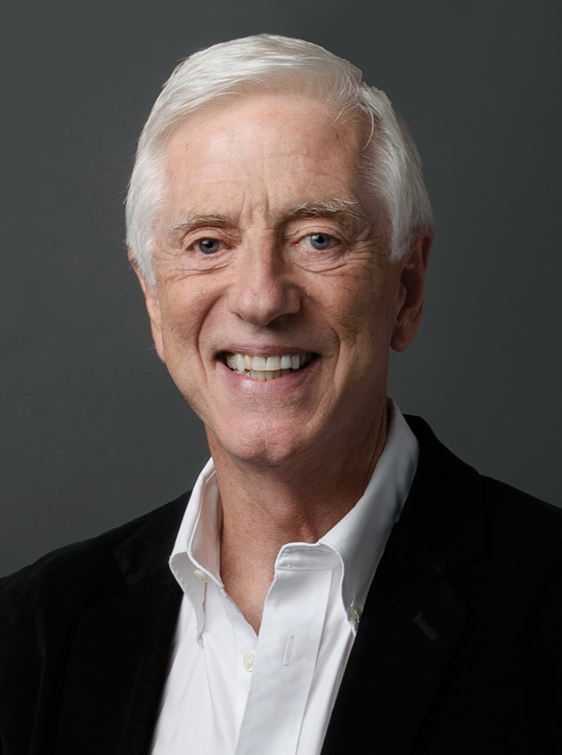
1. What is your vision for the Station Center neighborhood (200 South to 400 South; 450 West to 600 West)? What investments do you think the City should make in this area?
I envision this area (between the Rio Grande depot and the Intermodal Hub) as the premiere place for a new Urban Village, connected to the entire Wasatch Front and beyond by all forms of transportation––buses, commuter rail, light rail, bicycles, automobiles, and pedestrian.
Featured here would be five or more densely populated (10-25+ stories) mixed-income non-market apartment buildings (with ground-level restaurants, bars, art studios/galleries, and markets) with world-class design. It would all be surrounded by open space, parks, playgrounds, an Olympic-size skating rink in the winter and, during non-winter months, kiosk restaurants and shops, with movable chairs and tables––fashioned after Bryant Park in Manhattan.
Below are images of examples of the mixed-income non-market, housing-secure apartments that could be built in the Station Center neighborhood:
From Francesca Mari, (photographs by Luca Locatelli), “Imagine a Renters’ Utopia,” The New York Times Magazine, May 23, 2023, found at https://www.nytimes.com/2023/05/23/magazine/vienna-social-housing.html.Id.
“30 of the World’s Most Impressive Social Housing Projects,” found at https://www.bestmswprograms.com/impressive-social-housing-projects/.
Presently, the city is taking the failed approach of subsidizing market housing, by giving many millions of public dollars to private profit-driven developers for building housing that is mostly unaffordable, but which contains a relatively few units (mostly studios or one-bedroom units) that called “affordable,” usually at the 80% AMI level, but which is unaffordable to most people seeking to live in Salt Lake City. Tenants in such housing are usually housing-insecure insofar as they never know when the market will lead to rising rents that will be beyond their means.
To overcome the affordability crisis, which is directly related to the homelessness crisis in SLC, we must take a very different approach.
"The quest to provide what has come to be called “affordable housing” in America is hobbled by one fundamental reality. Too much housing is in the market sector and too little is in a social sector permanently protected from rising prices. The result is that supply and demand relentlessly bids up market prices. Government is required to provide deeper and deeper subsidies to keep rents within the bounds of incomes, so fewer and fewer people get any kind of help. This is true whether the form of public subsidy is tax breaks, direct subsidies, vouchers, or deals with developers to set aside some percent of units as affordable. In most cities, the median rent far exceeds what median incomes can afford. In cities with hot housing markets, homeownership is even further beyond reach for those who do not already own homes, exacerbating competition for scarce apartments." --Peter Dreier, “Why America Needs More Social Housing – Subsiding market prices to make housing affordable is a losing strategy. There’s a better way––on display for a century in Vienna,” The American Prospect, Spring 2018.
The city should invest in––and borrow to build––mixed-income non-market housing, the rents for which will be controlled by the city and not subject to the vagaries of the wildly shifting––rapidly increasing––housing market. This is an evidence-based approach that many nations are successfully taking, with respect to housing for renters and owners. (For instance, 80% of Singaporeans own their homes, under a government 99-year lease program. In Vienna, 60% of people live in non-market––“social––housing.)
Removing the profit margin from housing, alone, is a major factor in achieving lower rents. So too would be treating affordable housing as a city’s responsibility in the public interest, just as cities do with respect to libraries, airports, roads, and municipal buildings.
A vital additional benefit would be that the city would have the duty to ensure that the housing would be architecturally excellent, just as Salt Lake City made sure stunning design would be incorporated in our Main Library. The public has a significant interest in a high-quality built environment, which could be achieved with non-market housing––and which is not now being achieved by most private developers who are building largely boxy, industrial-like, unaffordable housing of poor or mediocre design.
The design and construction of the non-market housing would be of high enough quality that it would attract many higher earning people as well as those who earn less. That would enhance the mixed-income aspect of the housing, which is of tremendous benefit to all. Diversity in all its forms makes our lives and communities more creative, interesting, and empathic.
2. What are the most important initiatives and investments you will lead to create a safe and welcoming downtown for residents, workers, employers and visitors?
The most vital initiative and investment leading to a safe and welcoming downtown at this time would be to remove all homeless encampments from throughout our city by providing a humane sanctioned camp, which, with professional outreach and case management, can be a springboard for transitioning out of homelessness. The details of my conclusions about what should be done to address the homelessness crisis in our city are set forth in answer to Question #4 below.
Our downtown in many areas is not currently safe and welcoming, nor is it perceived by most as safe and welcoming, for residents, workers, employers, and visitors. Actors from New York City, performing in a play at Pioneer Theatre, who were housed in a hotel downtown, requested that they be moved to a safer place near the University of Utah. On the day I am drafting these responses, I learned from Teresa Bowman, owner of Mid City Salon, that she is, sadly, closing her salon on 300 South between Main Street and West Temple because of numerous horrible encounters with untreated mentally ill homeless people, as well as criminals among the homeless population. They have driven away salon clients and employees alike.
Mid City Salon is joining the ranks of such terrific, long-term businesses as Southam Gallery and Latter Day Brides, who have left Salt Lake City because of unresponsiveness by city government to filth (including the frequent presence of human feces and urine), assaults, property destruction, public masturbation, and conspicuous illegal dangerous drug sales and use.
This is a city crisis. Although we need resources from many sources, including the state and county, churches, and the philanthropic and business communities, to help alleviate it, the city’s mayor is primarily responsible for ensuring that there is an effective plan developed and that it is effectively implemented. Unlike the current mayor, I will embrace that responsibility.
"Leaders of cities are the first and last line of defense in the battle, balancing the need to ensure safe and humane solutions for people without shelter with the need to maintain their city’s quality of life for all inhabitants. . . . Those at the helm are left with the hard task of convening the many parties and hammering out solutions. An effective solution demands that local actions among multiple agencies, government and nongovernmental, be coordinated––something mayors are uniquely positioned to do. In each of the ten cities discussed in this book, mayors stepped forward to define the problem and craft the solution. * * *Some mayors, however, refuse, or prove inadequate to, the task." --Linda Gibbs, Jay Bainbridge, et al., How Ten Global Cities Take On Homelessness––Innovations That Work (University of California Press, 2021), at 22 (emphasis added).)
We need to take an entirely different approach to crime and homelessness than what our city is currently doing. We must take the evidence-based measures that respect and promote the interests of residents, members of the homeless community, and businesses alike. Compassion must be exercised toward all as we pursue solutions that benefit everyone.
I worked downtown for decades. During the last few years of my law practice in the Judge Building at 300 South Main Street, I was distressed at how homeless people living on the street were completely ignored by the city and homeless providers, with no outreach workers helping transition them out of homelessness and no one working to get those who needed it into treatment for drug addiction or mental illnesses.
I was also upset that those of us working in the downtown area were subjected frequently to conspicuous use of dangerous drugs (one man shooting up heroin in broad daylight three mornings in a row on the bench a few yards from Main Street), drugged-out bodies lying on the sidewalks, including on Main Street, human feces and urine, and daily screeching by obviously untreated mentally ill people.
I pleaded with the mayor and a councilmember in a series of letters to provide help for homeless people and to provide safe public bathrooms (required by the international human right to decent sanitation), only to be met with a maddening indifference toward unsheltered people living on our streets and toward those of us whose quality of life had badly deteriorated.
We must end the sense of impunity created by the mayor and her Chief of Police throughout our city. Oftentimes, police do not even respond to 911 calls (as when Mid City Salon called for police assistance when a homeless man masturbated in front of a salon full of female employees and clients) or, when they do respond, they are often late (with an absurdly slow goal of 10 minute responses, which goal is usually not met) or do nothing, explaining to business owners that they’ve been told by the mayor to simply tell the offenders to “move on.”
Because of the almost total absence of enforcement of many laws, including drug laws, and the lack of any deterrence, many people have been led to believe they can commit any number of crimes without any accountability. The best thing that can happen for most drug abusers is to be arrested, then diverted from jail if they undergo effective drug treatment, with long-term follow-up.
Generally, I favor a restorative justice approach, where the focus is on problem-solving rather than on punishment. Drug abusers could avoid having a record of a criminal conviction if they enter a plea of guilty, then the court holds it in abeyance until successful treatment and follow-up is pursued. Drug Court has been a tremendous success in pursuing that approach. Just looking the other way, as our police do now at the behest of the mayor, is detrimental to the drug abuser and destructive to the community as a whole. We should do all we can to get people with drug problems into treatment, demonstrating compassion for everyone involved, including residents and businesses that have suffered so much because of the widespread conspicuous dealing and use of dangerous drugs throughout our city.
3. Salt Lake City’s Central Business District population will double in the next two years. How can the City enhance and expand green space and public spaces to support a healthy and vibrant downtown neighborhood?
I believe the city has made several significant mistakes at Gallivan Center, which could have far more green space and more adequate room for audiences if so many structures had not been built. Although parking is needed downtown, it was a particularly egregious mistake to take so much of Gallivan Center for a parking lot. We should learn from those mistakes. Open space is to be treasured and preserved, not covered with structures (especially parking lots). That’s why I fought for years (successfully, thank goodness) to save the open space surrounding the Main Library, which was, according to previous plans, to be covered by housing.
We can add substantially to the downtown’s green space by creating parks––even small historical pocket parks––at every opportunity. The city should work with current property owners and explore the possibility of providing parks in areas not in use now.
Large open spaces, including parks and playgrounds, would be included in the Urban Village described in the response to Question #1 above. (See the first photo in that response as an example.)
We should expedite the exploration of the advisability of the Green Loop and, if it is tenable, the timetable for construction and completion should be sped up significantly. The Green Loop has been under discussion since about 2016. Decisions should be made without unnecessary delay and we should move forward right away if it is to happen. We don’t need more pop-up demonstration parks, surveys, consultants, and excuses for delay.
Town squares are often found in cities throughout Latin America, Europe, and elsewhere. They are a social center of cities, where people––families, singles, young and old––can mingle, get to know each other, and enjoy the community coming together in the town square. Such a town square could be created on a side street downtown and could be part of the plan for the Station Center Urban Village. Regardless of where it is located, we should commit to creating a town square and finding a means of people there enjoying music, relaxation, and having a beer or wine without embarrassing restrictions.
4. What is your plan for responding to the crisis of people living without shelter on the streets of Salt Lake City? Will you enforce no-camping ordinances? Please include your strategies for funding the initiatives that you propose.
An effective, evidence-based approach is outlined in detail here: https://www.rocky4mayor.com/homelessness-crisis-response-plan.html. That approach, which is diametrically the opposite of the mayor’s, is to immediately (1) eliminate encampments in parks, neighborhoods, and the rest of our city by creating a safe sanctioned camp, remote from neighborhoods and businesses (at the closed Wingpointe golf course, for instance) with showers, meals, property lockers, and case management to transition people out of homelessness; (2) provide outreach and case management for all homeless people in the city, including those staying in shelters; and (3) enforce the laws and divert people, as possible, to appropriate drug and mental health treatment. Then provide adequate, humane shelter for those who would otherwise be left out in dangerous weather conditions and reverse the “scattered” shelter approach, where people are far from other homeless services, such as the 4th Street Clinic.
Any time a shelter or homeless housing facility receives a permit from the City, a condition should be imposed for a publicly transparent means of providing regular management and operations data so that metrics of success or failure can be known and evaluated. We should do whatever is required to ensure that the placement of shelters or homeless housing will not undermine the quality of life for neighbors, as has occurred, for instance, in the neighborhoods of the Gail Miller Resource Center and the Magnolia.
We must insist that the County provide adequate mental health and addiction treatment, including in-patient services. Then we should provide far more cost-effective (not expensive new construction, like the Magnolia) permanent supportive housing, with accountability for tenants, respecting the interests of other residents and the neighborhood. Ultimately, we should create a campus where all homeless services will be in close proximity to each other––and at a location where businesses and residents will not suffer a deterioration of quality of life as a result of the services, as has occurred in the neighborhoods near the present “scattered” shelters.
We should also invest in the protection of people on the verge of homelessness from becoming homeless, including tenant emergency assistance, the provision of abundant mixed-income non-market affordable housing at all income levels (see response to Question #1 above), and coordination with jails, prisons, and health facilities so no one will be released without housing.
The elements of this proposal will be financed by several people and institutions that will be excited to finally be able to contribute toward a coherent, evidence-based plan that will move us toward significant success in reducing homelessness.
When I was mayor, Salt Lake City Housing Authority built the first supportive permanent housing facility, the 100-unit Sunrise Metro. Then many more supportive permanent housing projects were built in rapid succession, including Grace Mary Manor, Valor House (at the V.A. Hospital), Freedom Landing, Palmer Court (210 units). Among the financing partners for those projects were private philanthropists (e.g., Jack Gallivan and the George S. and Delores Doré Eccles Foundation), the Church of Jesus Christ of Latter-Day Saints (contributing $7 Million toward the purchase of an old Holiday Inn for Palmer Court), and other governmental entities (e.g., the Salt Lake County Housing Authority and federal government funds). After the flurry of building permanent housing for chronically homeless people, Utah was known nationwide as setting an example for other states and cities who sought to eliminate chronic homelessness. (See “Utah Reduced Chronic Homelessness by 91 Percent; Here’s How,” npr (All Things Considered), December 10, 2015; “The Shockingly Simple, Surprisingly Cost-Effective Way to End Homelessness,” Mother Jones, February 17, 2015. Although the results may have been partially a result of a change in determining who would be counted as being “chronically homeless,” significant advances had been made in Salt Lake City—until the building of permanent supportive housing for chronically homeless people came to a screeching, inexplicable halt for nine years beginning in 2010. We need to once again commit ourselves to providing adequate supportive permanent housing on an aggressive schedule.
All levels of government, the business community, churches, and the philanthropy community will join together when we can demonstrate that great progress is likely in reducing homelessness when we pursue evidence-based, cost-effective solutions like those I have outlined. (Much of what I’ve found to work has been demonstrated by Haven for Hope in San Antonio. For a virtual tour of Haven for Hope, visit https://www.youtube.com/watch?v=6FzfI6gPB0k.)
Also, the state and Salt Lake County receive funds to provide mental health services, which they have not been doing sufficiently. They must be held to a higher standard and be accountable for providing the badly-needed mental health services for which they receive funding.
We should divert people who have drug abuse problems from jail and prison to effective drug treatment programs whenever possible. The costs of drug treatment will be less than continuing to incarcerate those people. Finally, people who are not incarcerated should have access to drug treatment on demand—which will be far less expensive than dealing with the ravages of drug addiction, including the costs to victims of crimes committed by drug addicts.
5. Please share your strategies for attracting and retaining employers and skilled workers to Salt Lake City.
We have already lost prospective employers because of the homelessness crisis, especially since there is no coherent, evidence-based plan to resolve it. One commercial real estate broker told me about a large company that was exploring a move to SLC. After two days in SLC, they said to him, “Why the **** would we move to Salt Lake City? We’re trying to get out of San Francisco.”
Parents seek, first and foremost, a hometown where their children will be safe and benefit from exceptional schools and programs. We should acquaint any potential employer or employee with the extraordinary programs we have for young people. First, any parent would be impressed by the extraordinary after-school and summer program I created when I was mayor before, YouthCity. It has made a real, positive difference in the lives of many thousands of young people and will continue to do so.
Also, I will implement a city-wide childcare program with an enriched curriculum for all children pre-kindergarten. It will be affordable to all, accepting vouchers from the Division of Workforce Services and charging those who do not have vouchers on a sliding-scale basis. It would be modeled on the outstanding, award-winning Stepping Stones program in St. George.
We should aggressively acquaint any potential employer with the diversity and creativity of our city. Already, most people have a stereotype of SLC that is probably not helpful in attracting new employers. We should do everything we can to break the perception of that stereotype, including introductions to leaders in the arts and culture community, the academic community, and the ethnic minority community.
We should be very proud, and show how proud we are, of many things in our city, including the fact that we have one of six national full-time opera companies and one of 16 full-time symphony orchestras. For a city our size, that is unique, but how many prospective new employers ever learn of that as they’re making their decisions?
As mayor, I will always be available to meet with potential new employers or employees to help acquaint them with our incredible community. (Before the 2002 Winter Olympic Games, our city was being maligned in the international press as a boring place with nothing to do. That was all reversed when, before the Games, I took a busload of reporters out on the town, showing them much of our exciting nightlife. Candus Thomson, “Not Quite Sin City,” October 31, 2001, The Baltimore Sun.)
Much can be done to encourage new companies, which began at the University of Utah, to stay in Salt Lake City and to hire employees from here. We should collaborate with diverse, creative communities in engaging with those companies. The most creative cities attract the best new talent.
It would also help to encourage the Utah Legislature to stop passing legislation that drives new companies and employees away. The abortion bills passed by the Legislature, which are cruel and dangerous to women, are repellants for anyone considering moving to Salt Lake City. The business community throughout the state should unify in a non-partisan effort to persuade the Legislature to do much better.
Unique places, like a major new town square or the Urban Village described in the response to Question #1 above, will help attract businesses and talented, skilled employees. Special, creative, welcoming, community-building events and places are what matter most to people. In that connection, I will revive the free-of-charge three- or four-day Salt Lake City International Jazz Festival, which we produced, along with Jerry Floor, for seven years.
6. How can the City best support the Utah Jazz’s long term residency in Downtown Salt Lake City?
We should first ask Ryan Smith. We can guess all we want, but we should seek to know what Jazz owners want to see happen. After all, none of us really seem to know why Gail Miller decided to move the Bees out of Salt Lake City. There is only speculation about what it might have taken to retain the Bees––but the most reliable information would be by having Gail Miller tell us. It’s unfortunate that she hasn’t done that so we could learn more about what might be done in the future.
I’m sure that it would help if Jazz players and staff were more engaged in the community and presented (as it appears Shaq O’Neal and Charles Barkley were not) with the many exciting, unique, and attractive features of our city and the region.
7. What is one of your favorite dishes from a restaurant in the Central Business District?
So difficult to choose, but at this moment: BTG’s Bar Bites, garlic shrimp, asparagus, and 5 Cheese Board – with a glass or two of Malbec.
8. What else would you like downtown property owners, merchants, employers and residents to know about your campaign for mayor?
As I’ve always done in my winning elections in Salt Lake City, we’re running a cost-effective, vigorous grassroots campaign, which has raised sufficient funds to run a reasonable number of ads on digital media, streaming television, and network TV, but which is focused primarily on “retail” campaigning—walking door-to-door, getting out several hundreds of yard signs (reflecting overwhelming grassroots support), and speaking frequently before groups, large and small.
I’m not a political partisan and have the support of many members of both major parties as well as third-parties and independents. I have great long-term support of people in the business community who know that I’m the person who will get important things done for our community. And I have support from residents throughout our city, east-side and west-side, who are incredibly dissatisfied with the failures of leadership in city government and the worsening problems of homelessness, crime (including police responses and refusals to even record illegal conduct), affordability, and poor maintenance of our streets and parks. I offer evidence-based solutions, which will bring about major improvements regarding the homelessness and affordability crises in Salt Lake City.
I have always been an enthusiastic supporter of a vibrant, clean, unique downtown that is truly livable. The prospect of leading our city to a recovery from the disastrous homelessness and affordability crises, with a commitment to promoting the interests of businesses, members of the homeless community, and residents alike is at the core of my passion, and the passion of my many tremendous volunteers and supporters, to win this race and help lead us toward a far better future.

